Old things are more beautiful
than many things brand new
Because they bring fond memories
of things we used to do.
Old photographs in albums,
love letters tied with lace,
Recapture those old feelings
that new ones can’t replace.
Baby shoes, a teddy bear,
a ring that grandma wore,
Are treasures waiting there behind
a door marked “Nevermore”.
Old things are more beautiful,
more precious day by day
Because they are the flowers
we planted yesterday.
Through the eyes of innocence, I began a journey, a never ending journey of time travel and discovery.
A journey that would teach me, more than I ever thought possible, about history, love, loyalty, loss, sacrifice, triumphs and tribulations.
Ever since the begin, one particular family has drawn me in and taught me more about love and sacrifice than any other.
The Willats family.
What I’ve discovered, through historical documents, and long lost relatives, their lives have truly made their mark on mine. They are all beyond fascinating.
One man’s love, in particular, has captured my heart and is the reason why, I have given every spare moment of my time, to researching his legacy. And even though I am one hundred percent sure, there is so much more to his life story, than can’t be discovered on the internet or in archives, it’s the greatest honour to share what I do know about this incredible man.
before I begin to tell you a tiny fragment of his story, let’s look at his/our family Willats.
The surname of WILLATS and its variant Willet, was a baptismal name meaning the descendant of Little Will, a pet form of William (resolution, helmet); dweller near the Willett (stream), a river in Somerset; one who came from Willet, a village in County Somerset. Early records of the name mention Willot de Foxwist in 1286. Stephen Wilotes of the County of Worcestershire in 1327. John Wilot of Yorkshire was listed in the Yorkshire Poll Tax of 1379. Originally the coat of arms identified the wearer, either in battle or in tournaments. Completely covered in body and facial armour the knight could be spotted and known by the insignia painted on his shield, and embroidered on his surcoat, the draped garment which enveloped him. Between the 11th and 15th centuries it became customary for surnames to be assumed in Europe, but were not commonplace in England or Scotland before the Norman Conquest of 1066. They are to be found in the Domesday Book of 1086. Those of gentler blood assumed surnames at this time, but it was not until the reign of Edward II (1307-1327) that second names became general practice for all people. A later instance of the name mention John Avery and Elizabeth Willett were married at St. George’s, Hanover Square, London in 1764. During the Middle Ages, when people were unable to read or write, signs were needed for all visual identification. For several centuries city streets in Britain were filled with signs of all kinds, public houses, tradesmen and even private householders found them necessary. This was an age when there were no numbered houses, and an address was a descriptive phrase that made use of a convenient landmark. At this time, coats of arms came into being, for the practical reason that men went into battle heavily armed and were difficult to recognise. It became the custom for them to adorn their helmets with distinctive crests, and to paint their shields with animals and the like. Coats of arms accompanied the development of surnames, becoming hereditary in the same way. A notable member of the name was William Willett (1856-1915) the English builder born in Farnham. He is chiefly remembered for his campaign of ‘daylight saving’. A Bill was promoted in parliament in 1908, but opposition was strong and the measure was not adopted until a year after his death.
In honestly it wasn’t the easiest task finding any kind of information about the surname, Willats, luckily for us, I thankfully have so much more to share about his life than the meaning of his family’s name.
So without further ado, I give you,
The Life Of Richard Henry Willats, through documentation.

Welcome back to the year 1834, England.
The Monarch was William IV.
Prime Minister were Charles Grey, 2nd Earl Grey(Whig) (until 16 July), William Lamb, 2nd Viscount Melbourne (Whig) (starting 16 July, until 14 November), Arthur Wellesley, 1st Duke of Wellington (Tory) (starting 14 November, until 10 December) and Robert Peel (Conservative) (starting 10 December).
Foreign Secretary were Henry John Temple, 3rd Viscount Palmerston (until 14 November) and Arthur Wellesley, 1st Duke of Wellington (starting 14 November).
It was the 11th Parliament (until 29 December).
Sir Robert Peel formed his first government.
HMS Tartarus was launched at Pembroke Dock. It is the Royal Navy‘s first steam-powered man-of-war (a paddle gunvessel).
Much of the Palace of Westminster was destroyed by fire.
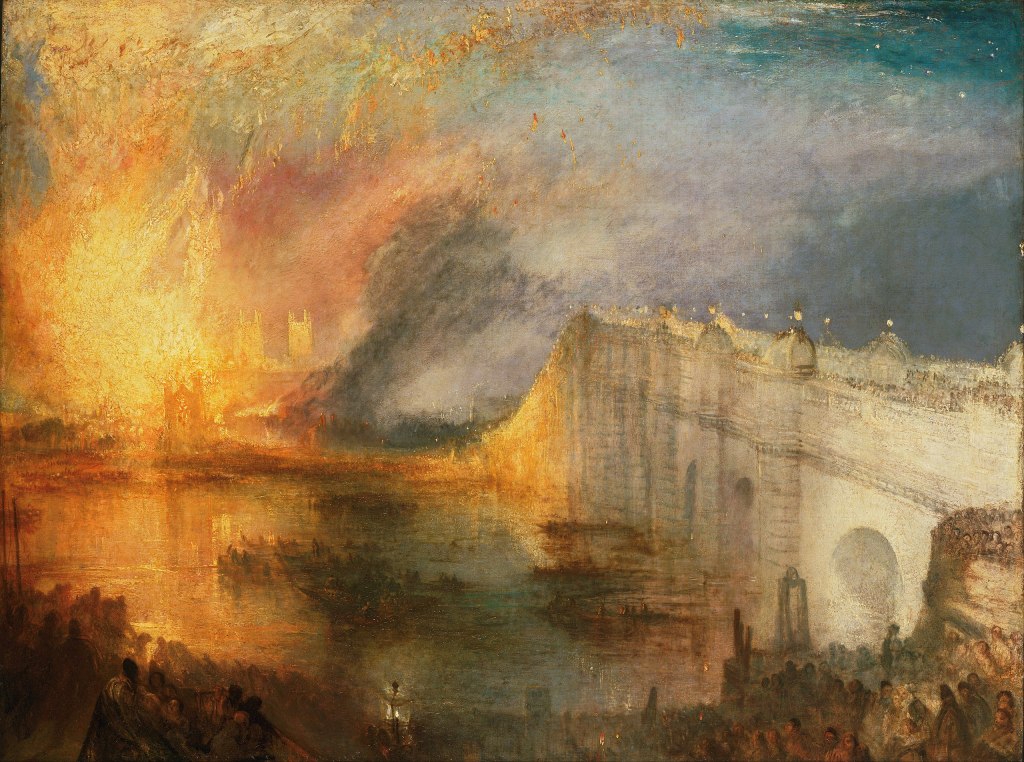
The first public railway in Ireland, opened between Dublin and Kingstown.
Poor Law Amendment Act stated the able-bodied could not receive assistance unless they enter a workhouse; poor-law authorities should no longer attempt to identify the fathers of illegitimate children to recover support from them.
Hanging in chains upon a gibbet after execution was abolished in England by the Hanging-in-Chains Abolition Act.
And my 4th Great Granduncle, Richard Henry Willats, was born on Wednesday the 13th of August, 1834, to George John Willats and Charlotte Woollet Carter, in St. Marylebone, London, England.

The census give his birth year and location as,
1841 – 1835 Middlesex,
1851 – 1834 St Giles,
1861 – 1834 St Marylebone,
1871, 1891 – 1835 Marylebone,
1881 – 1835 London City,
1901 – Ryenti Park, London
and 1911 – 1835 London.
Marylebone (usually /ˈmɑːrlɪbən/, also /ˈmærɪləbən/, /ˈmærɪbən/) is a district in the West End of London, in the City of Westminster. Oxford Street, Europe’s busiest shopping street, forms its southern boundary.
An ancient parish and latterly a metropolitan borough, it merged with the boroughs of Westminster and Paddington to form the new City of Westminster in 1965.
Marylebone station lies two miles north-west of Charing Cross.
Marylebone was originally an Ancient Parish formed to serve the manors (landholdings) of Lileston (in the west, which gives its name to modern Lisson Grove) and Tyburn in the east. The parish is likely to have been in place since at least the twelfth century and will have used the boundaries of the pre-existing manors. The boundaries of the parish were consistent from the late twelfth century to the creation of the Metropolitan Borough which succeeded it.
During the late-18th century, the main street became the Marylebone High Street we might recognise today, lined with shops and houses. The Portland Estate leased pieces of land out on 99-year leases, on which builders of all types built according to plans approved by the Estate. This led to a great variety of buildings in terms of style, size and occupancy. Tradesmen included an apothecary, baker, goldbeater, hairdresser, shoemaker and watchmaker. Alongside buildings developed by private speculators were others built for the public good, like the workhouse and schools and a police station that was opened in 1821.
As well as the rich and fashionable, the Marylebone parish had its share of poverty, homelessness and associated problems. Following its demise, the Marylebone Gardens area degenerated into slums, home to the poorest and most helpless, attracting beggars and criminals. Victorian reformers such as Octavia Hill and Lady Howard de Walden began to redevelop the houses around Grotto Passage and the ill-named Paradise Street from the 1860s onwards with what was effectively social housing, some of which still stands today. A ragged school for poor children was built in 1846 and clubs for poor and homeless opened.
The 99-year leases of the shops in Marylebone came to an end in the mid-late-19th century and many properties were modernised or completely rebuilt. The Portland Estate was keen to amalgamate small sites into larger properties, combining good sized shops with flats above, examples of which can still be seen today. Often these reflected changing shopping trends: on Marylebone High Street a clothing department store, Gaylor and Pope, opened at 111-118 in 1857, Sainsbury’s opened at number 99 in 1916, and a specialist bookshop opened at number 83 in 1883. Other buildings were redeveloped, including the old Rose tavern, which was reborn as Marylebone Music Hall (now 33 Marylebone High Street).

Four years later, Richards sister, Sophia Mary Ann Willats, was born on the 31st March 1838, in Saint Martin in the fields, Middlesex, England.

George and Charlotte baptism Richard Henry, on Sunday the 29th of July, 1838, at Saint Martin In The Fields, Westminster, London, England.
Richards sister, Sophia Mary Ann Willats and my 4th Great Grandfather, George John Willats, were also baptised.
Their father,Georges occupation was given as a Caver.
And their abode as, Johnson’s Place.



St Martin-in-the-Fields is a Church of England parish church at the north-east corner of Trafalgar Square in the City of Westminster, London. It is dedicated to Saint Martin of Tours. There has been a church on the site since at least the medieval period. It was at that time located in the farmlands and fields beyond the London wall, when it was awarded to Westminster Abbey for oversight.
It became a principal parish church west of the old City in the early modern period as Westminster’s population grew. When its medieval and Jacobean structure was found to be near failure, the present building was constructed in an influential neoclassical design by James Gibbs in 1722–1726. The church is one of the visual anchors adding to the open-urban space around Trafalgar Square.
Jumping forward to the year 1841, Queen Victoria sat proudly upon the throne.
Prime Minister was William Lamb, 2nd Viscount Melbourne (Whig) until 30 August and then Robert Peel (Conservative) (starting 30 August).
Foreign Secretary was Henry John Temple, 3rd Viscount Palmerston, until 2 September and then, George Hamilton-Gordon, 4th Earl of Aberdeen (starting 2 September).
It was the 13th (until 23 June) and 14th (starting 19 August) Parliament.
The first performance of Dion Boucicault‘s comedy London Assurance, was presented by Charles Mathews at the Theatre Royal, Covent Garden.
The London Library opens at 49 Pall Mall, London.
A fire at the Tower of London destroyed its Grand Armoury and caused a quarter of a million pounds worth of damage.
The Ulster Canal was completed.
And the United Kingdom Census was held on on Sunday the 6th of June 1841. It was the first to record names and approximate ages of every household member and was administered nationally.
The census shows, Richard, his parents George and Charlotte and his siblings, George and Charlotte, were residing at, Meard Street, St Anne Soho, Strand, London & Middlesex, England.



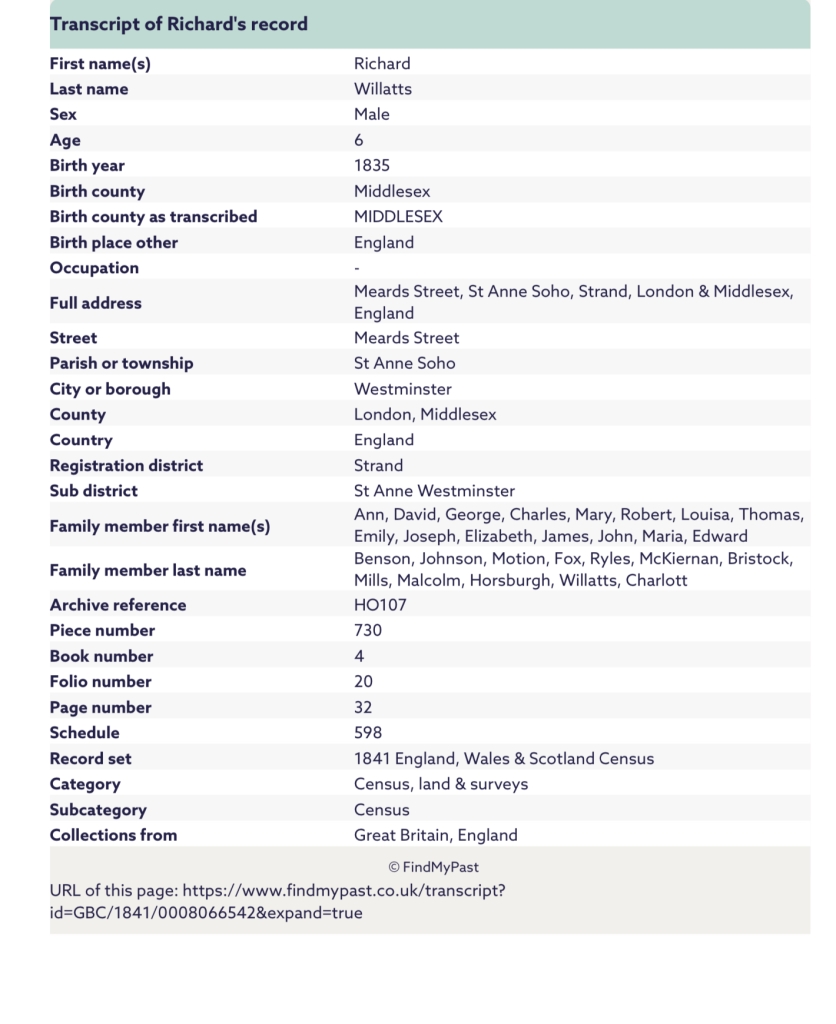
Meard Street is a street in Soho, London. It runs roughly east–west (properly, east-northeast to west-southwest, as elsewhere in Soho), between Wardour Street to the west and Dean Street to the east. It is in two sections, with a slight bend in the middle: the west half is pedestrianised, while the east half is a narrow, single-lane road.
The street is named after John Meard, the younger, a carpenter, later esquire, who developed it in the 1720s and 1730s, and the properties he designed and built, are still in situ to this very day – and as a result Meard Street is one of the few surviving London streets from the Georgian period
Its unique houses depict an almost perfect example of ‘Georgian’ architecture, which covered the period of time between 1713 and 1830, and is regarded as the greatest period of English architecture.
Meard was regarded as one of his generations most skilled carpenters – particularly throughout London – and at that period of time, carpentry was one of the most sought after skills and trades, because wood was the main component material of house building and construction.
In 1735 John Meard became a ‘Master of the Worshipful Company of Carpenters’ and worked with Sir Christopher Wren on St. Paul’s Cathedral and other iconic historical churches.
Numbers 1 – 3 – 5 & 7 Meard Street are a terrace of 4 single fronted houses, that are 4storeys high and with a basement – and still retain their original ‘Georgian’ architectural features which include:- a dog legged staircase – 3 evenly spaced front windows – wide piers between each house – brown stock bricks – stone sills – double hung sash-windows.
Numbers 1 to 7 and 2 to 6 were the very first houses to be sold off and occupied, and are still residential properties to this very day – some 300yrs since they were built.
The who’s who of Meard Street’s early owners/residents from the early 1700’s, reads as follow:-
No. 1 – Burkat Shudi – a harpsichord maker
No. 1 – (1738-42) the house became the Westminster Women’s Penitent Asylum
No. 7 – (1739-42) Rev Richard Terrick – who became the Bishop of London
No. 9 – Thomas Langley – who taught architecture to ‘young gentlemen’
No. 9 – (1758) Elizabeth Flint – rented a room within the house – whose character was documented within the community as:- “generally slut & drunkard – occasionally whore and thief”
No. 11 – (1755-70) Abraham Browne – 1st violinist in the King & Queens Band
Throughout the 18th & 19th centuries official records show that these properties in Meard Street were occupied by all sorts of people – for example:- a chess player / musicians / composers / writers / architects / enamel engravers & painters / artists & watchmakers
Fast forward to the 20th century and the Meard Streethouses still retained their prestige – and were occupied by numerous well to do people, plus some dodgy ones – many connected in some way to the legal & illegal Sohonight-life .
Apart from these magnificent historic houses – there is another ‘street fixture’ that makes Meard Street even more unique – it is the site of one of my favourite London ‘quirky’ landmarks – the “7 Noses of Soho”
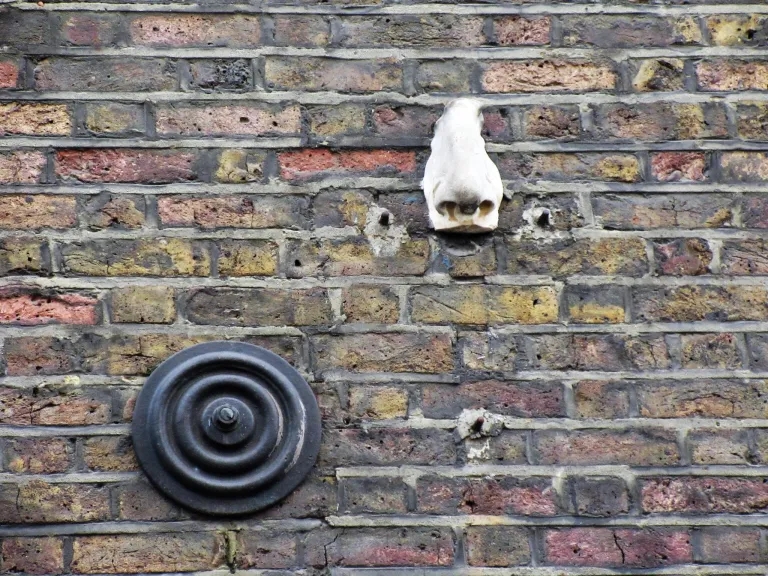
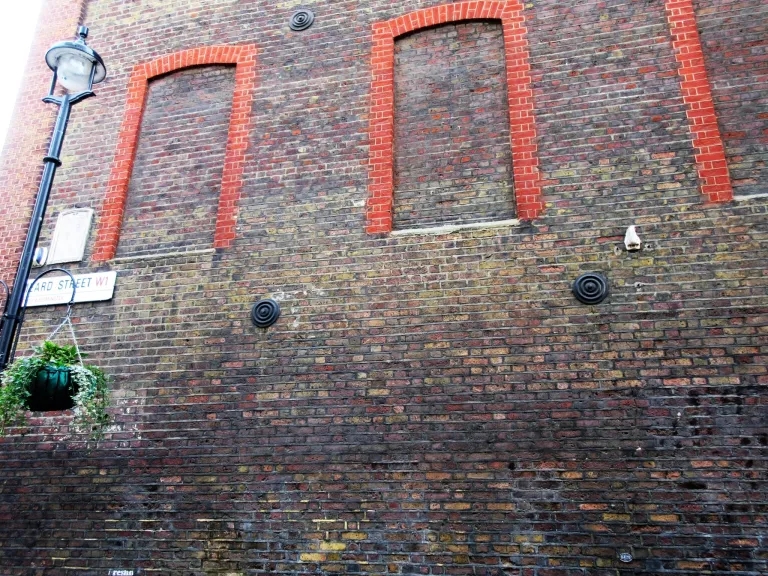
15 Meard Street served as the exterior of the home occupied by characters played by Ian McKellenand Derek Jacobi in the 2013–16 ITV sitcom Vicious.



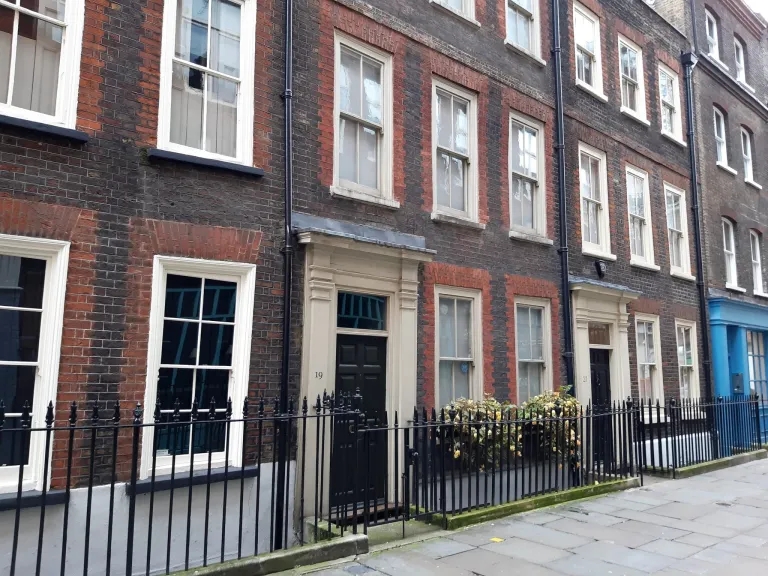
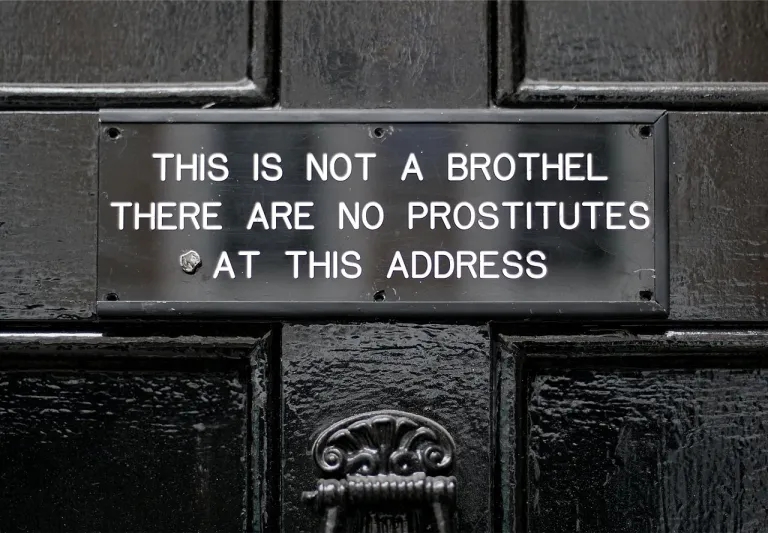

It was pretty handy that the Willats family were residing in such a grand large home as, the family just kept growing.
Richard’s brother, James William Willats, was born at 6pm, on Saturday the 17th of July, 1841, at, Number 3 Meard Street, Saint Anne, Westminster, Middlesex, England.
Their mother Charlotte registered James birth on Tuesday the 24th of August 1841, at Strand.
Charlotte gave her husband George’s occupation as a Craver and their adore as, 3 Meard Street.
James family is very interesting and I can not wait to share a little of their lives and connections with you all.

George and Charlotte baptised James William Willats, on Sunday the 16th of January, 1842, at St Anne’s Church, Westminster, London, England. George gave his name as John.
George’s occupation was given as a Craver and their abode as, Meard Street.

Saint Anne’s Church serves in the Church of England the Soho section of London. It was consecrated on 21 March 1686 by Bishop Henry Compton as the parish church of the new civil and ecclesiastical parish of St Anne, created from part of the parish of St Martin in the Fields. The church is under the Deanery of Westminster (St Margaret) in the Diocese of London.
Parts of its churchyard around its west including tower are now the public park of St Anne’s Gardens, accessed from the Shaftesbury Avenue end of Wardour Street. The church is accessed via a gate at that end of Dean Street.
The parish, having spawned new churches to Saints Thomas and Peter in the era of compulsory church attendance, reconsolidated on Saint Anne’s in 1945.

Richards sister, Elizabeth Frances Willats was born on Tuesday the 18th of June, 1844, in, Middlesex, England.
Tracking down her birth index to order her certificate wasn’t the easiest, nothing seemed to fit perfectly.
I found one possible match but the mothers maiden name is given as Tillett and not Carter. Their mothers name is Charlotte Woollet Carter, so my thinking is that Charlotte may have given her maiden name as Woollet and it was transcribed wrong But the year is off by a year, so I’m really not so sure. I have added it to my long list of certificates I need to order.

George and Charlotte, baptised Elizabeth Frances Willats on Sunday the 15th of September, 1844, at the parish church of St. Anne, Soho, Westminster, London, England.
Elizabeths birth date was given as the 18th of June. Her father’s occupation as Carver and their abode as Meard Street
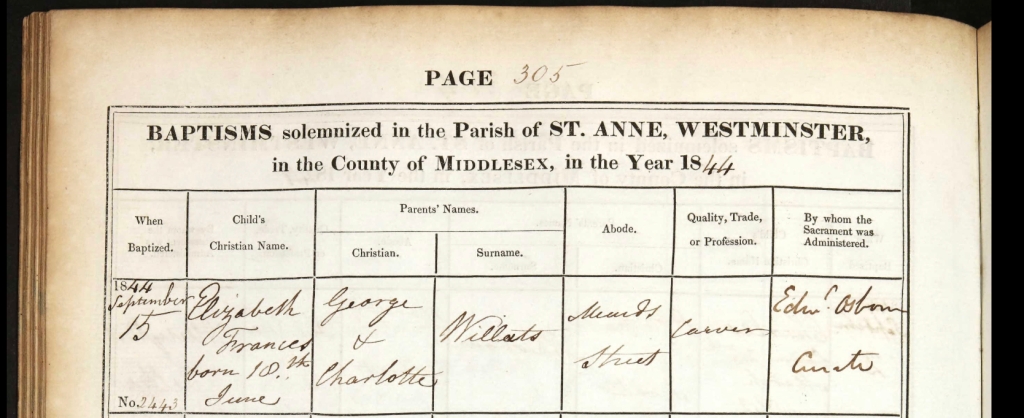
Heartbreaking times fall over the Willats family, when Richards 8 year old sister, Sophia Mary Ann Willats, died on Tuesday the 4th of March 1846, at The Middlesex Hospital, All Souls, St Marylebone, Middlesex, England.
Sophie died from an Abscess of the shoulder from a fall in the street, terminating in pericarditis in 18 days.
J. Walleye, Corona,of Number 35 Bedford Square, was present and registered her death at St. Marylebone, on Monday, the 13th of March, 1848.
Sophias death was registered in the name, Mary Ann Willats.

George and Charlotte laid Sophia to rest on Sunday the 8th of March, 1846, at St. James Church, Westminister, London, England.
Her name was given as Mary Ann Willatts.
Their abode was given as Meard’s Street, St Ann’s.


St James‘s Church, Piccadilly, also known as St James’s Church, Westminster, and St James-in-the-Fields, is an Anglican church on Piccadilly in the centre of London, United Kingdom. The church was designed and built by Sir Christopher Wren.The church is built of red brick with Portland stone dressings. Its interior has galleries on three sides supported by square pillars and the nave has a barrel vault supported by Corinthian columns. The carved marble font and limewood reredos are both notable examples of the work of Grinling Gibbons. In 1902, an outside pulpit was erected on the north wall of the church. It was designed by Temple Moore and carved by Laurence Arthur Turner. It was damaged in 1940, but restored at the same time as the rest of the fabric
Thankfully just over a year later, the family had reason to smile again, when Richards sister, Jenny Eliza Willats, was born on Saturday the 19th June, 1847 in Middlesex, England.
Unfortunately, there doesn’t seem to be a birth index for her, not that I have found anyway. Thankfully her baptism gives us her birth date and their abode, which shows there is a great possibility that Jenny was born at, Meard Street, Soho, Westminster, England.

George and Charlotte, baptised Jenny on Sunday the 26th September 1847, at St Martin In The Fields, Westminster, London, England.
George’s occupation was given as Craver and their abode as Meard’s Street.
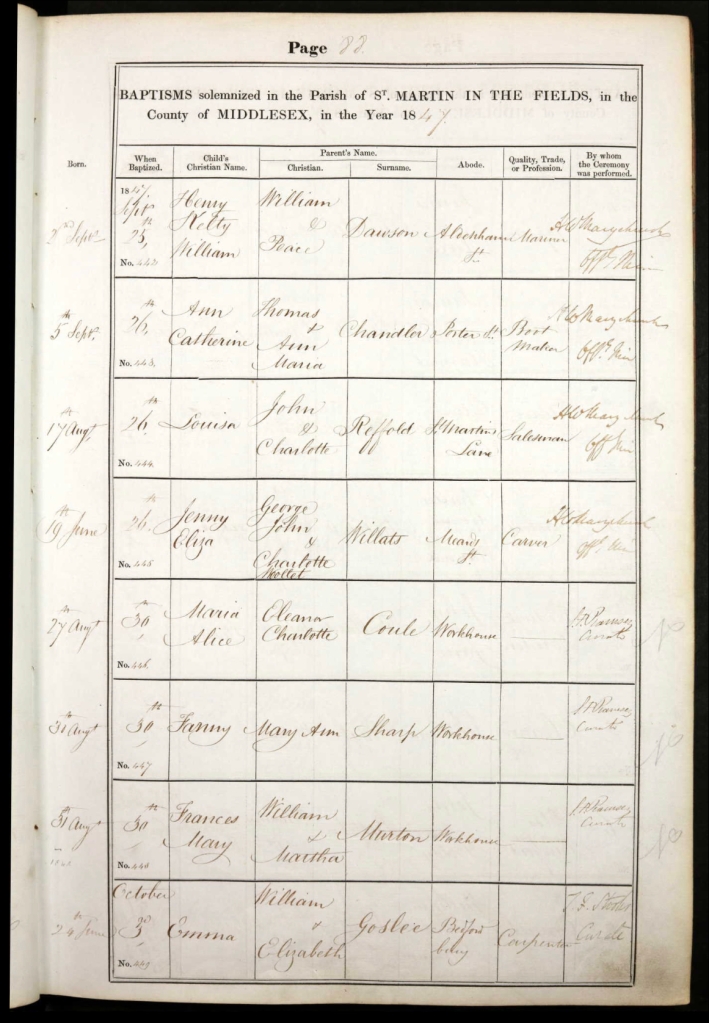
Jumping forward to the year 1851, England.

Queen Victoria sat upon the throne. Prime Minister was Lord John Russell (Whig). Foreign Secretary was Henry John Temple, 3rd Viscount Palmerston (until 26 December) and Granville Leveson-Gower, 2nd Earl Granville (starting 26 December). It was the 15th Parliament.
Sculptor Frederick Scott Archer made public the wet plate collodion photographic process.
The Royal School of Mines was established, as the Government School of Mines and Science Applied to the Art.
Exiled Hungarian regent-president Lajos Kossuth arrived at Southampton. After a tour of the UK and 6 months in the United States, he spent 8 years in England.
Labouring Classes Lodging Houses Act permitted local authorities to appoint commissioners to erect or purchase houses for the working classes, but was little used.
The card game Happy Families was introduced by Jaques of London.
An explosion at Victoria Pit colliery, Nitshill killed 61 men and boys.
Bell’s whisky was first blended.
Donaldson’s Hospital opened in Edinburgh, primarily for the education of deaf children.
And the 1851 Census was held on Sunday the 30th March 1851.
It shows that Richard was residing at, Maccles Fields Street, Saint Anne Westminster, Strand, London & Middlesex, England, with Mr. Eli Brawlow and his family.
Richard was undergoing an apprenticeship in Engravering.
Mr. Eli Brawlow was a Ornamental engraver.

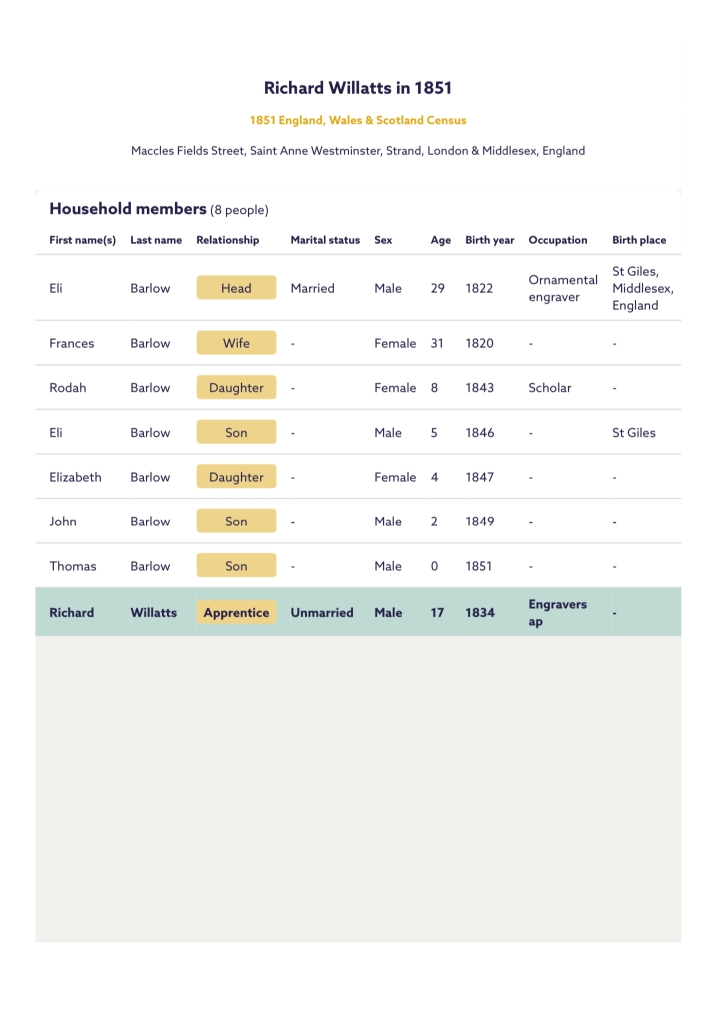

Richards mentor Eli Barlow, sadly was found dead in 1901. His death and inquest was reported in many newspaper including the following article from the Henley & South Oxford Standard, on the 18th of January, 1901.

Richards brother, my 4th Great Grandfather, George John Willats, married a lady named Eliza Cameron, on the 13th June 1852, at St John’s, Waterloo, Lambeth, Surrey, England, an Anglican Greek Revival church in South London, built in 1822–24 to the designs of Francis Octavius Bedford. It is dedicated to St John the Evangelist, and with St Andrew’s, Short Street, forms a united benefice.
Eliza and George were both of full age, single and residing at Ann Street.
George was working as a Violin Maker.
Eliza’s Father was working as a Tailor and George’s Father, George Willats was working as a Carver.
Their witnesses were, C. Williamson and Louisa Beacham.
George and Eliza went on to have one son, my 3rd Great Grandfather, William John Willats, whom was born on the 15th July 1853, at 90 Dean Street, St. Anne Westminster, Middlesex.
His Father George, was working as a, Musical Instrument Maker.
Eliza and George, were residing at 18 Marshall Street, Golden Square.
Eliza registered William’s birth on the 25th July 1853.
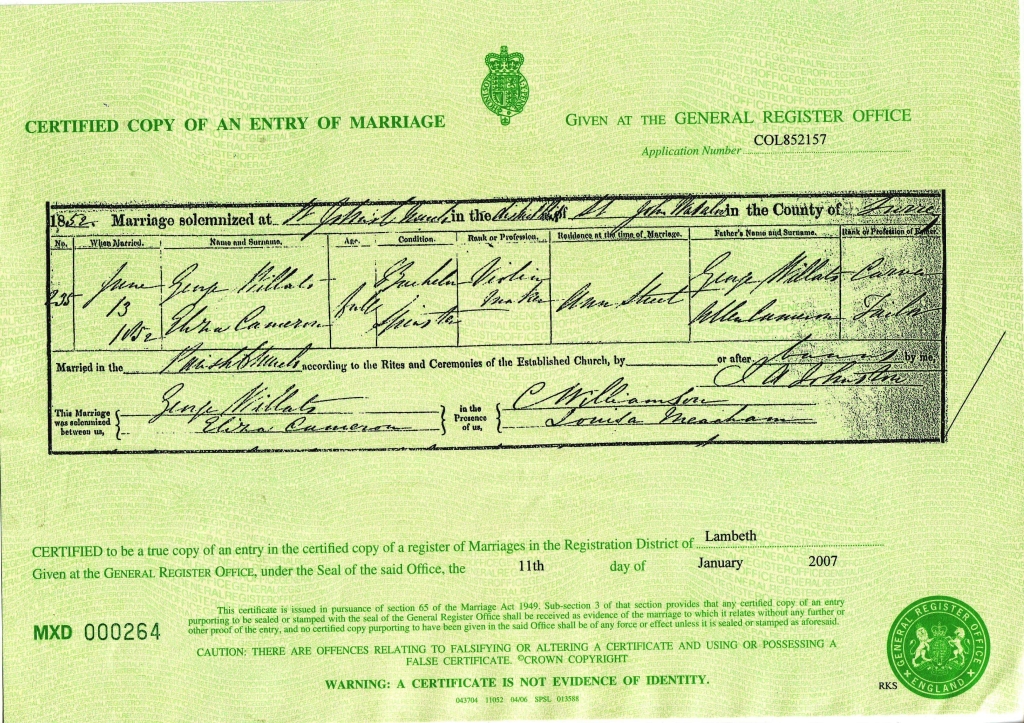
St John’s Church, Waterloo, is an Anglican Greek Revivalchurch in South London, built in 1822–24 to the designs of Francis Octavius Bedford. It is dedicated to St John the Evangelist, and with St Andrew’s, Short Street, forms a united benefice.
The church is located in Waterloo, opposite the London IMAX, close to Waterloo station and the Waterloo campus of King’s College London.
In 1818, when the country was settling down into a period of peace after the Napoleonic Wars and the population was beginning to expand rapidly, Parliament decided to allocate a sum not exceeding a million pounds for the building of additional churches in populous parishes and “more particularly in the Metropolis and its Vicinity.” Of this sum, the Commissioners for Building New Churches appropriated £64,000 in 1822 for the needs of the parish of Lambeth. It was decided that a new church should be built on the Waterloo Bridge approach, with a piece of ground on the east side of the road to be purchased from the Archbishop of Canterbury and his lessee and the sub-lessee, Gilbert East and a man named Anderson.
Bedford designed three other churches for the Commissioners, St George’s, Camberwell, St Luke’s Church, West Norwood and Holy Trinity, Newington. They were all built in the same Greek style inspired by Bedford’s background as a well-respected Greek scholar and antiquarian. Bedford’s churches were fiercely criticised by contemporary critics at a time when the tide was turning away from the Greek revival towards Gothic. St John’s however gained more critical appreciation mainly because of its fine spire which used classical detail to build up a more traditional English parish church shape.

Eliza and George’s marriage is rather important to Richard’s life story, as at some point between their marriage on the 13th June 1852 and early 1856, Eliza and George’s marriage broke down and Eliza and Richard began a relationship.
The reasons are unknown.
However Richard took over the roll as father, to my 3rd Great Grandfather, William John Willats aka Biggun, and it wasn’t long before they started their own family.
Richard and Eliza’s son, Henry Richard Willats was born on Monday the 8th of December, 1856, at Number 30 Poland Street, Berwick Street, St James, Westminster, Middlesex, England
Richard Henry Willats, gave his occupation as a Tailor and abode as, Number 30, Poland Street, when he registered Henry’s birth on, the 8th January, 1856, at Berwick Street, Saint James, Westminster.

The 1766-1946 UK city and directories, shows Richard Henry, working as a Tailor at, 4 Stafford Street, Bond Street, London, England, in 1856.

Richard and Eliza’s son, Francis Montague Allen Willats was born on Thursday the 17th of September, 1857, at Number 30 Golden Square, St. James, Middlesex, England. Richard Henry, gave his occupation as a, Master Artificial Flower Maker and his abode as, 30 Golden Square, St. James, Westminster, when Richard registered Francis birth on the 29th of October 1857.

Artificial flowers were used to adorn hats, dresses and even women’s hair. Often also found in home parlours, artificial flowers are just one example among the many domestic and fashion accessories of the period that illustrate how a seemingly harmless product could render the working and domestic environments toxic.
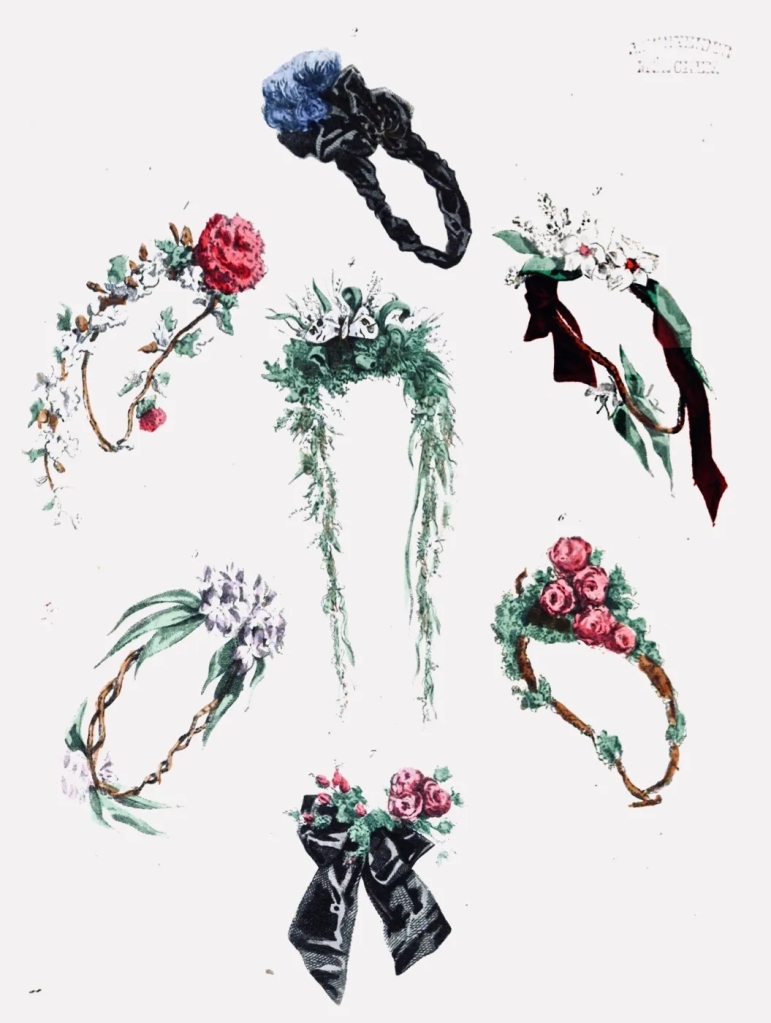
From the 1850s onwards, artificial flowers became particularly fashionable in Britain but their production was not subject to factory inspection. However, flower-makers were particularly susceptible to develop arsenic poisoning as the flowers they created were made out of fabric coated with arsenical pigments such as Scheele’s green or emerald green. These two colours were frequently used to tinge the leaves of artificial flowers. While the pigments adhered to the paper and to the worker’s hands, they also generated arsenical dust within the workspace. In 1859, French hygienist Maxime Vernois documented the hardship of workers in the industry, noting how arsenical dust made the workshops insalubrious and providing sketches illustrating the ailments that workers developed due to constant exposure to paint itself. Yet flower-making involved more than just one toxic substance. The yellow dye picric acid and the red dye fuchsine, an aniline dye derived from the distillation of coal-tar, were also dangerous to handle. In 1876, the doctor and member of the Academy of Medicine Auguste-Louis-Dominique Delpech (1818-1880) described how some flower-makers were in the habit of licking their fingers to better handle the coloured papers and fabrics they had to assemble, thus ingesting part of the colour. According to his observations, picric acid poisoned two young women working in the trade, causing their tongues to swell to such an extent that they could no longer eat. Workers were further at risk of developing aniline poisoning, for example when crafting red roses using fuchsine. This colour contained the toxic substance benzine and could also contain traces of arsenic. Workers frequently developed headaches, became nauseous and anaemic, and could die from overexposure to the substance. In 1877, forensic surgeon Eduard Hofmann and chemist Ernst Ludwig from the University of Vienna investigated the death of a mother and her daughter, who had both been artificial flower-makers. They performed an autopsy of the bodies and concluded that fuchsine had poisoned both women.

The history of toxic colours in the artificial flower trade invites scholars to further investigate the gendered dimension of occupational diseases in the nineteenth century, which only few historians of the field have addressed.[8] While women working in large industries and workshops were frequently exposed to toxic colours, they were not the only ones at risk. In a flower-making manual published in 1854, Elisabeth Bayle-Mouillard mentions that children also worked in the trade, while middle-class ladies pursued artificial flower-making as a hobby.[9] Male workers were exclusively hired to dye the fabrics, and were thus exposed in different ways.[10] At the turn of the nineteenth century, new legislation, such as the 1897 Workmen’s Compensation Act in Britain and a 1898 law on workplace accidents in France, guaranteed a minimal protection for workers using toxic substances, but its efficacy was limited. Manufacturers increasingly subcontracted work to impoverished families, who worked at home. New factory health and safety regulation did not apply in the domestic sphere, further exposing the poorest classes—mostly women and children—to occupational poisoning caused by this dangerous cocktail of toxic colours.
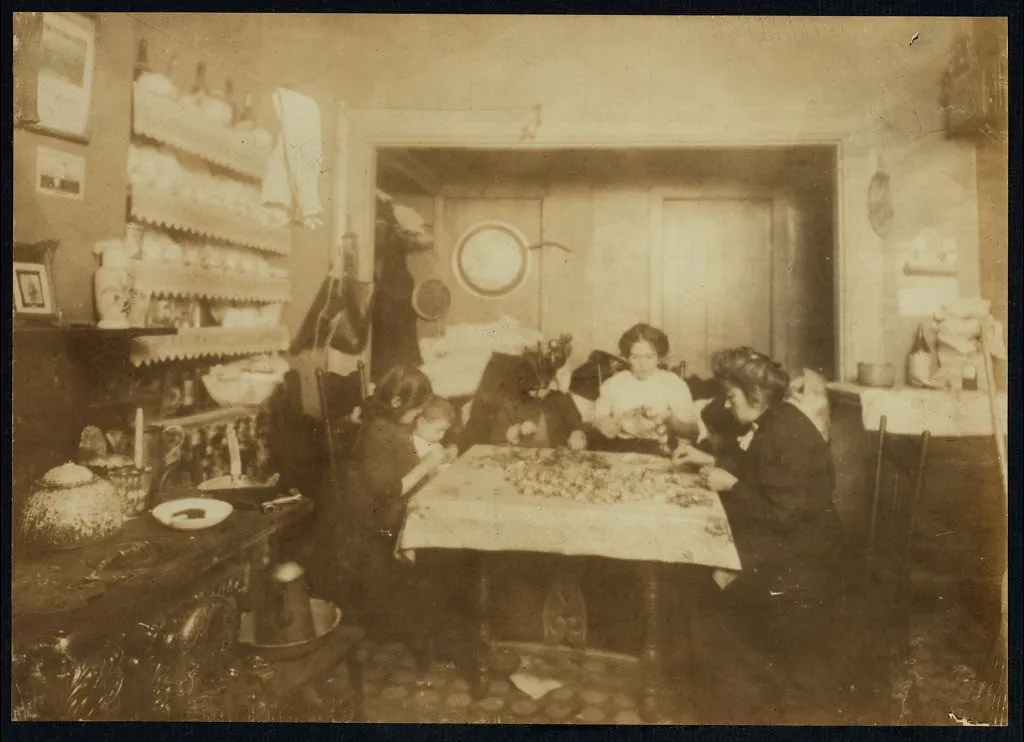
The following year, the 1832-1965, London Electoral Registers, shows Richard was residing at number 32, Saint Martins-Court, St Martin in the Fields, London, England, in 1858.

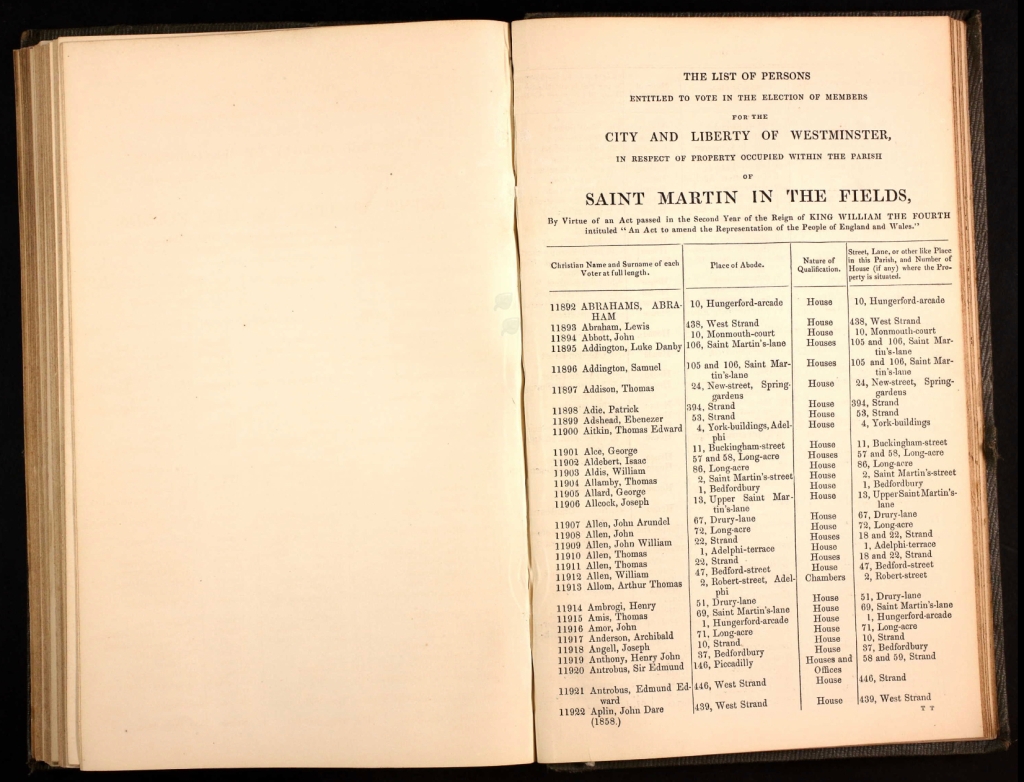
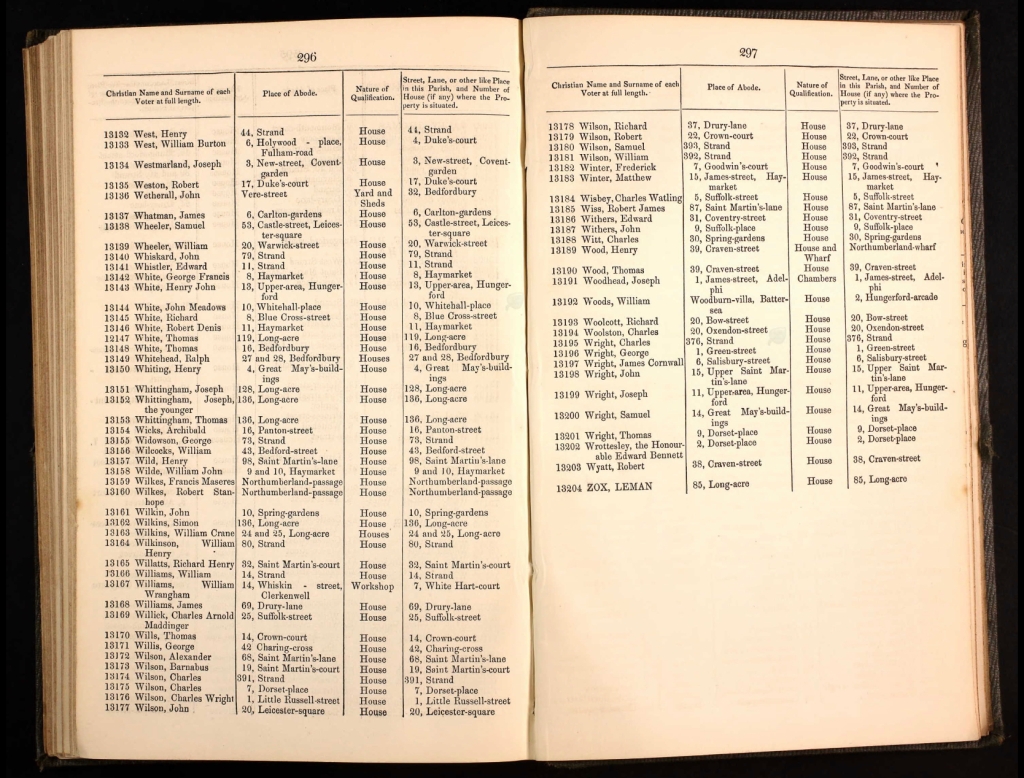
Prior to 1832 the only people who could vote in General Elections in the United Kingdom were men who owned freehold property that was worth over 40 shillings. On rare occasions women could also cast a vote at general elections in the eighteenth century (at times when, for example, her property-owning husband was absent on business; some borough franchises also accorded the right to vote to people, irrespective of their sex, simply because they met the property and rate-paying qualifications). While the property qualification was fairly low in terms of its affordability, very few people owned freehold property. The majority of the population in Britain being renters or tenants-at-will, or even living on manorial lets that their families had occupied since time immemorial, meant that the franchise was limited to a very small number of the adult population.

When people went to the polling stations in the eighteenth century, they voted in the constituency where their property was based. For example, the antiquary Joseph Ritson (1752–1803), although he lived in London, had to travel back to his home town of Stockton-on-Tees to cast a vote because that was where his property was situated. And when people cast their ballots, they did so for MPs to represent them at a county or borough level, and each of these returned two MPs. However, many of the up-and-coming manufacturing towns and cities such as Leeds and Manchesterwere not represented at all in parliament. Some boroughs like Old Sarum, which was nothing but a virtually uninhabited hill with a cottage in the early nineteenth century, meanwhile returned two MPs to parliament. Boroughs such as these were nicknamed ‘rotten boroughs’ for obvious reasons. It seemed as though the electoral system was not fit for purpose—and many agreed.
The following year, Richard and Eliza’s daughter, Charlotte Ellen Willats was born on Wednesday the 10th of August, 1859, at 56, Bunton Street, St Pancras, Middlesex, England.
Richard was working as a Commercial Traveller.
Eliza registered Charlotte’s birth on Tuesday the 13th of December, 1859.

Richard and Eliza, baptised Charlotte Ellen Willats, on Thursday the 1st of September, 1859, at the Old Church, Saint Pancras, London, England. Richard’s occupation was given as an Engraver and their abode as, Mabledon Row.

And the 1861 census was held on Sunday the 7th of April 1861.
It shows Richard residing at 34, Charlotte Street, Marylebone, London & Middlesex, England, with his children/stepchildren, George, Henry, Frank, and Charlotte and his mother Inlaw Mary Falconer and a servant, Susan Smith.
Richard was working as a commercial traveller, and Eliza as a Artificial florist.




The occupation of commercial traveller emerged during the eighteenth century in the form of «bagmen», who rode on horseback to distribute goods to trade customers who were either retailers or manufacturers. As such they were distinct from peddlers who sold goods directly to the public at fairs. They displayed goods, samples or trade catalogues to customers; obtained orders; and collected and remitted payments on previous orders. Moreover commercial travellers were important sources of intelligence about the affairs of their customers, the activities of competitors and the general state of business. Their role in Britain attracted attention from pioneering individual studies by Jeffreys, Payne and Westerfield, but generally business historians treated them as largely invisible foot-soldiers, their qualities and effectiveness were assumed, in effect, to reflect general characteristics of firms, industries or economies. Critical appraisals of British entrepreneurship compared British travellers unfavourably with multilingual and well-resourced German salesmen capturing British export markets, particularly in engineering.
Equally the innovative marketing techniques of large-scale American corporations were taken as markers of British backwardness in some consumer goods trades. For Chandler or Friedman, small and medium-sized British companies lacked the capacity to develop their marketing capabilities and larger firms were too cautious to undertake the required combination of innovations in production, marketing and managerial hierarchies. From these perspectives British salesmen were either as poorly equipped in terms of education and expertise or deprived of the key tools of a modernising trade by conservative employers who took no interest in or actively rejected new
practices.
In these analyses the key issues were the organisational structures within
which commercial travellers operated and the character of their sales practices. Structurally salesmen either worked for wholesalers or agencies, who distributed goods on behalf of many producers or they were employed directly by manufacturers. The use of wholesalers or agency houses was well-established by 1850 with some specialising on overseas trade. Chapman emphasised the key role of merchant houses, especially in London, for Britain’s textile trade. Where industries clustered in particular districts, such as the Sheffield cutlery, West Midland hardware or Birmingham jewellery trades, wholesalers were closely linked to the numerous small and medium-sized enterprises. These industrial districts allowed small manufacturers to reap the advantages of specialisation in production and access to skilled labour and to draw on the services of the wholesalers to maximise the distribution of their products in an alternative paradigm to that of volume production and distribution within a single large firm. For manufacturers, selling via wholesalers reduced overhead costs plus the time and expense required to establish connections with large numbers of individual retailers. In the most direct defence of British sales methods, Nicholas argued that merchant houses were highly effective mechanisms for reducing risks in distributing generic products, that manufacturers deployed their own travellers or those of agencies in a sophisticated way and that extensive overseas branch networks were evidence of initiative and enterprise. More recently, Hannah emphasised that decentralised systems of production and distribution were well- adapted to serving the densely-clustered urban economy in Britain supported by sophisticated transport, financial and commercial infrastructures.
Nonetheless by 1900 some manufacturers were directly hiring their own salesmen particularly in the grocery and branded consumer goods sectors, textiles and drapery, which were also among the first mover industries in North America and Europe. Where a manufacturer had a distinctive brand, establishing their own salesforce increased their capacity to influence the effort devoted to their selling own goods compared with agents who represented several brands. Closer contact with customers offered greater scope to promote repeat business and to acquire information about market conditions. Not all industries were suited to direct marketing by manufacturers, particularly where products remained essentially generic, hence the persistence of wholesalers and agents. And not all firms possessed the scale, capital or initiative required to engage salesmen, so in many sectors direct selling by manufacturers co-existed with use of wholesalers and agents.
The entry of manufacturers into wholesaling via their own salesmen has also been associated with the modernisation of sales methods that, arguably, changed the appearance, style and behaviour of salesmen, a shift encapsulated in the shift from the commercial traveller to the sales representative.

Heartbreakingly, Richards mum, Charlotte Woollet Carter, wife of George John Willats, a master craver and mother of 8, died on the same day, Sunday the 7th of April, 1861, at number 6, Meard Street, Soho, Westminster, London, England when she was 58 years old.
Charlotte died from Cancernora of the Uterus, 14 months.
Charlottes daughter, Charlotte Abraham nee Willats, was present and registered Charlottes death on Monday the 8th of April, 1861.
I do have a copy of her death certificate, which I was kindly gifted, so unfortunately I can not share it here but you can order your own copy of the certificate or a pdf certificate with the below information.

Charlotte Woolet Willats nee Carter, was laid to rest at, St Pancras Cemetery, Camden, London, England, on Friday the 12th of April, 1861, in grave Z10/72, with 17 Others.

St Pancras Cemetery is also known as East Finchley Cemetery and Islington and St Pancras Cemetery, with Islington Crematorium.
Islington and St Pancras Cemetery is a 190-acre cemetery in East Finchley, three miles to the north-west of Alexandra Palace.
The cemetery actually comprises two separate burial grounds – Islington and St Pancras – which together have around 1 million interments, making it the largest cemetery in the UK in terms of the number of burials. The site is classed as a Grade II English Heritage listed building.
The cemetery was established in 1854, after the St Pancras Burial Board purchased 88 acres on Finchley Common – land which was previously known as Horseshoe Farm. This became London’s first municipally-owned cemetery. A further 94 acres were purchased in 1877, after which the cemetery was split into sections for Islington (north-west and eastern boundary) and Camden (centre, north and south west). Although the boundary no longer exists its remains can still be seen.
Since the site opened there have been around 812,000 burials, 56,000 cremations and a number of reinternments from other demolished graveyards.
The site includes:
- Islington Civilian War Memorial
- Islington Commonwealth War Memorial
- St Pancras Civilian War Memorial
- St Pancras War Graves and Commonwealth War Memorial
- Islington Chapel
- St Pancras Chapel
We visited the cemetery a few years ago and it’s very impressive. We hoped to locate the graves of our ancestors who were laid to rest here, but it was very over grown and disappointingly we had no hope of finding them. We hope to go back in the near future.
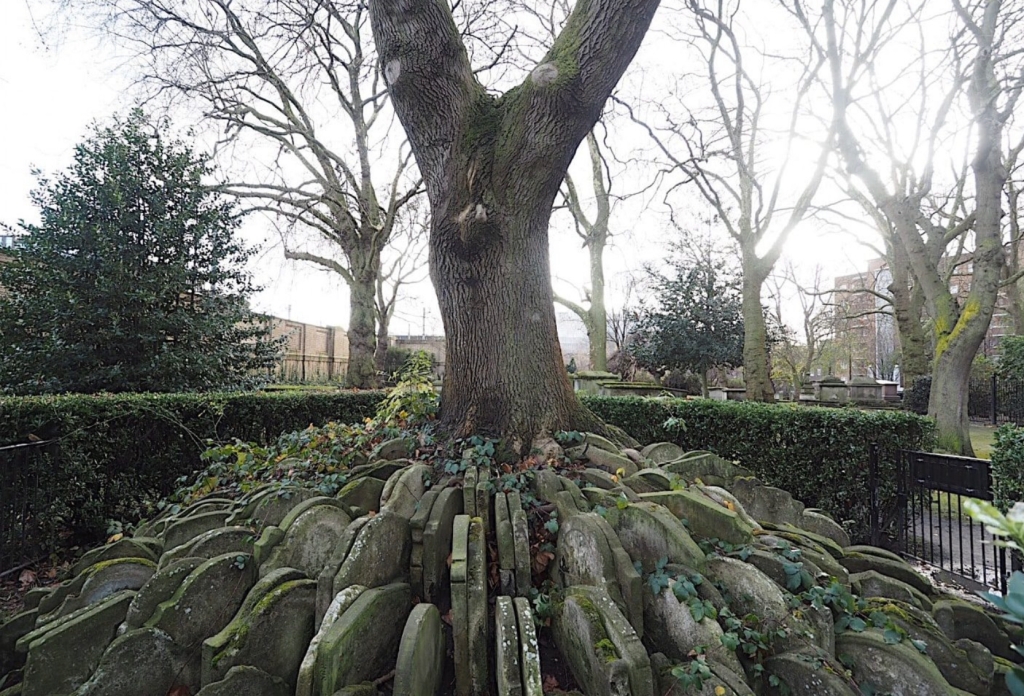
St Pancras Cemetery.
In January 2023 disaster struck the famous Hardy Tree. Over the past years the ash has been weakened by a fungal infection and strong winds have finally toppled this historic site.

St Pancras Cemetery.
While the Willats were in grieving, Richard and Eliza baptism Francis Montague Allen and Henry Richard Willats, on the 21st July 1861, at Holy Trinity Church, Marylebone Road, Westminster, London, England.
Richard gave his occupation as a commercial travelling and their abode, as 34 Charlotte Street.


Just a few short months later, Richard and Eliza welcomed their daughter, Edith Cameron Willats into their world, hearts and home, on the 20th of October, 1861, at their home, number 34, Charlotte Street, Marylebone, Middlesex, England.
Richard Henry, gave his occupation as a Commercial Traveller when he registered Edith’s birth on the 25th of November, 1861.

Eliza and Richard welcomed a son into the growing family on the 11th of July, 1863, at their home, Number 37, Charlotte Street, Marylebone, Middlesex, England.
They named him Arthur Charles Willats.
Richard Henry, gave his occupation as a Commercial Traveller, when he registered Arthur’s birth on the 21st August 1863.

Richard and Eliza, baptised their son and daughter, Arthur Charles and Edith Cameron Willats, on Sunday the 9th August, 1863, at Holy Trinity Church, Marylebone Road, Westminster, Middlesex, England. Richard’s occupation was given as a Traveller and their abode as Number 37, Charlotte Street.

Richard and Eliza, welcomed their new born son into their hearts, home and family, on Friday the 13th January 1865.
They named him, Walter James Willats.
Eliza gave birth at their home, Number 37, Charlotte Street, Marylebone, All Souls, Middlesex, England.
Richard registered Walters birth on the 9th of March 1865.
He gave his occupation as a commercial traveller and their abode as, 37, Charlotte Street, Marylebone.

Richard and Eliza, baptised Walter James, on Sunday the 26th February, 1865, at Holy Trinity Church, Marylebone Road, Marylebone, Middlesex, England.
Richards occupation was given as a commercial traveller and there abode 37 Charlotte Street.

Richard and Eliza, decided it was time to celebrate their love by finally legalising the union.
Their banns were read, at St John the Evangelist, Smith Square, London, England, on the Sunday 9th and Sunday 16th of April, by W.S. Bruce and again on Sunday the 23rd April, 1865, by J. Graham.

St John’s Smith Square is a redundant church in the centre of Smith Square, Westminster, London.
In 1710, the long period of Whig domination of British politics ended as the Tories swept to power under the rallying cry of “The Church in Danger”. Under the Tories’ plan to strengthen the position of the Anglican Church and in the face of widespread damage to church buildings after a storm in November 1710, Parliament concluded that 50 new churches would be necessary in the cities of London and Westminster. An Act of Parliament in 1711 levied a tax on coal imports into the Port of London to fund the scheme and appointed a commission to oversee the project. Archer was appointed to this commission alongside, amongst others, Hawksmoor, Vanburgh and Wren. The site for St. John’s was acquired from Henry Smith (who was also Treasurer to the Commissioners) in June 1713 for £700 and building commenced immediately. However, work proceeded slowly and the church was finally completed and consecrated in 1728. In total, the building had cost £40,875. The church was built by Edward Strong the Younger a friend of Christopher Wren the Younger.
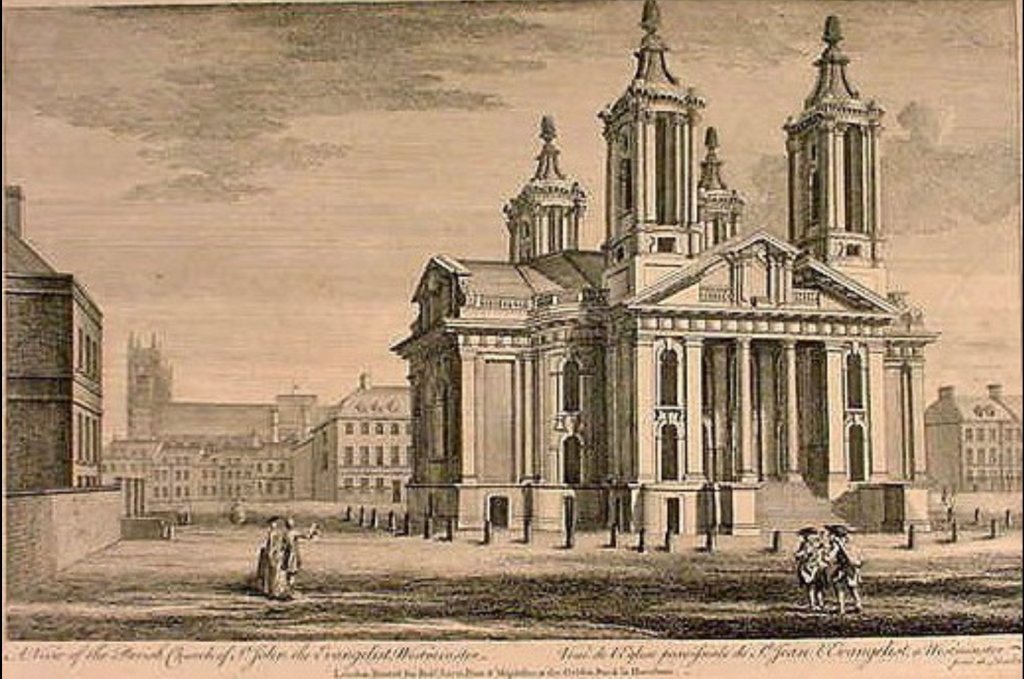
in the 18th century
Richard Henry finally married the love of his life and soulmate, Eliza Willats nee Cameron, on Thursday the 4th of May, 1865.
They married at, St Margarets, Westminster, London, England.
Richard was a Bachelor.
Eliza was listed as a widower, which is rather strange as her first husband George John Willats (Richard Henry Willats brother) didn’t die until later that year.
Their witnesses were, George John Willats, Patrick’s brother and Eliza’s first husband and Eliza’s sister, Mary Cameron.
Eliza and Richard, were residing at 10 North Street.
Richard was working as a, Commercial Traveller.
Eliza’s Father, Allen Cameron was working as a Tailor and Richard’s Father, George John Willats, was working as a Wood Craver.

I have no idea as to how Richard and Eliza were able to marry, as it was strictly forbidden to marry a brothers wife even a deceased brother.
Family story’s state that, a sympathetic member of the clergy came to their rescue and had the first marriage annulled.
I guess we will never know for sure but it seems that maybe something fishy was going on as George John married Sarah Elizabeth Southall Jukes, in Victoria, Australia, in 1856 (11years before Richard and Eliza wed. George and Sarah, went on to have 4 Children. George John, stayed in Australia until his death, visiting England frequently.

in the grounds of Westminster Abbey on Parliament Square, London, England
St. Margaret’s, known as ‘the Church on Parliament Square’, is a 12th-century church next to Westminster Abbey. It’s also sometimes called ‘the parish church of the House of Commons’.
The Church of St Margaret, Westminster Abbey, is in the grounds of Westminster Abbey on Parliament Square, London, England. It is dedicated to Margaret of Antioch, and forms part of a single World Heritage Site with the Palace of Westminster and Westminster Abbey.
The church was founded in the twelfth century by Benedictine monks, so that local people who lived in the area around the Abbey could worship separately at their own simpler parish church, and historically it was within the hundred of Ossulstonein the county of Middlesex. In 1914, in a preface to Memorials of St. Margaret’s Church, Westminster, a former Rector of St Margaret’s, Hensley Henson, reported a mediaeval tradition that the church was as old as Westminster Abbey, owing its origins to the same royal saint, and that “The two churches, conventual and parochial, have stood side by side for more than eight centuries – not, of course, the existing fabrics, but older churches of which the existing fabrics are successors on the same site.
In 1863, during preliminary explorations preparing for this restoration, Scott found several doors overlaid with what was believed to be human skin. After doctors had examined this skin, Victorian historians theorized that the skin might have been that of William the Sacrist, who organized a gang that, in 1303, robbed the King of the equivalent of, in modern currency, $100 million. It was a complex scheme, involving several gang members disguised as monks planting bushes on the palace. After the stealthy burglary 6 months later, the loot was concealed in these bushes. The historians believed that William the Sacrist was flayed alive as punishment and his skin was used to make these royal doors, perhaps situated initially at nearby Westminster Palace. Subsequent study revealed the skins were bovine in origin, not human.
You can read more about, St Margaret’s here.

The sad news of Richard’s brother John George Willats, death reached the family later that year, 1865, from Victoria Australia.
George John Willats died after the 19th June 1865 when he arrived back in Australia after being witness at Richard and Eliza’s wedding.
I’m not sure what their relationship was like, but going off the fact that Richard had brought Johns son up and was later witness to his first wife’s marriage to Richard, I have an overwhelming feeling they were all on good terms.
Sadly more death followed when Richards sister, 41 year old widow of commercial traveller, David Condon, Julia Elizabeth Condon nee Willats, sadly passed away on Sunday the 11th of March 1866, at Sheffield Terrace, Kensington Town, Kensington, Middlesex, England.
Julia died from, Phthisis.
Elizabeth Gilbert of Holland Street, Kensington, was present and registered Julia’s death on Tuesday the 13th of March, 1866, in Kensington.

Julia was laid to rest at, on Friday the 16th of March, 1866, at Brompton Cemetery, Westminster, London, England, in a 8ft common grave, O263.ox26.0.
Julia’s residence was given as 1, Sherfield Terrace, Kensington.


Brompton Cemetery (originally the West of London and Westminster Cemetery) is a London cemetery, managed by The Royal Parks, in West Brompton in the Royal Borough of Kensington and Chelsea. It is one of the Magnificent Seven cemeteries. Established by Act of Parliament and laid out in 1839, it opened in 1840, originally as the West of London and Westminster Cemetery. Consecrated by Charles James Blomfield, Bishop of London, in June 1840, it is one of Britain’s oldest and most distinguished garden cemeteries. Some 35,000 monuments, from simple headstones to substantial mausolea, mark more than 205,000 resting places. The site includes large plots for family mausolea, and common graves where coffins are piled deep into the earth. It also has a small columbarium, and a secluded Garden of Remembrance at the northern end for cremated remains. The cemetery continues to be open for burials. It is also known as an urban haven for nature. In 2014, it was awarded a National Lottery grant to carry out essential restoration and develop a visitor centre, among other improvements. The restoration work was completed in 2018.
Although the cemetery was originally established by a private company, it is now the property of the Crown.

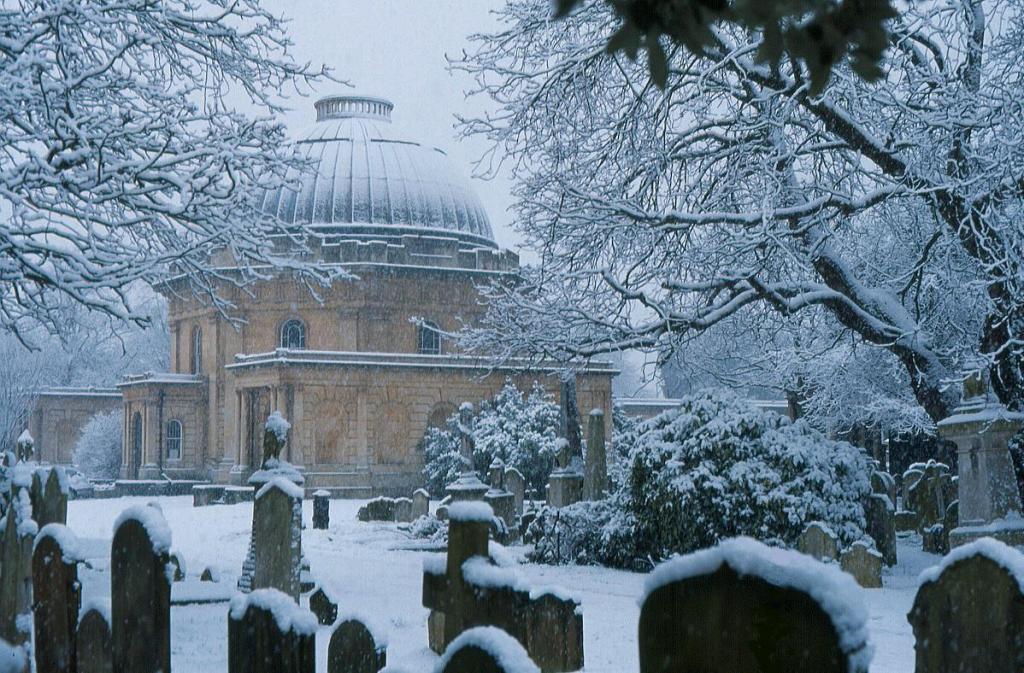
After the sad news of George’s and Julia’s death, Richard and Eliza soon had a reason to smile when Eliza gave birth to a baby girl whom they called, Eliza Mary Willats.
Eliza Mary was born on Wednesday the 20th of March, 1867, at Number 37 Charlotte Street, All Paul’s, Marylebone, Middlesex, England.
Her Father Richard was working as a Buyer …. at the time of her birth.
Eliza registered Eliza’s birth on the 29th April 1867.
Eliza was known as Polly.

Richard and Eliza baptised Eliza Mary, on Sunday the 21st of April 1867, at Holy Trinity Church, Marylebone Road, Marylebone, Middlesex, England.
Richards occupation was given as Saleman and their abode as, 37 Charlotte Place.
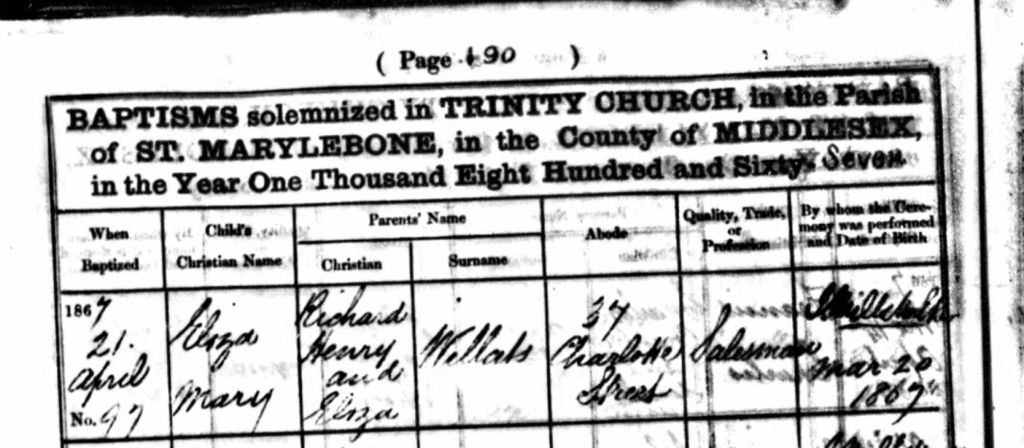
And it wasn’t long until Richard and Eliza were once again in the family way.
Eliza gave birth to her 9th child, Richard and her, 4th Daughter, on Monday the 4th of October, 1869, at, Number 38, Regent Square, Greys Inn Lane, Pancras, Middlesex, England.
Eliza and Richard named her, Lilly Jenny Willats.
Her Father Richard, occupation was listed as a Traveller ( Feathers).
Eliza registered her birth on the 15th January 1869.

Richard and Eliza baptised Lillian Jenny Willats, on Sunday the 31st of October, 1869, at Saint Peter’s Church, Regent Square, London, England.
It was a private baptism.
Richards occupation and abode were given as, Warehouse man and 38 Regent Square.

Devastatingly Saint Peters in Regent Square was hit by bombs in the war and had to be demolished. Unfortunately there doesn’t seem to be much information about it online. From the below image, it was a very impressive building.
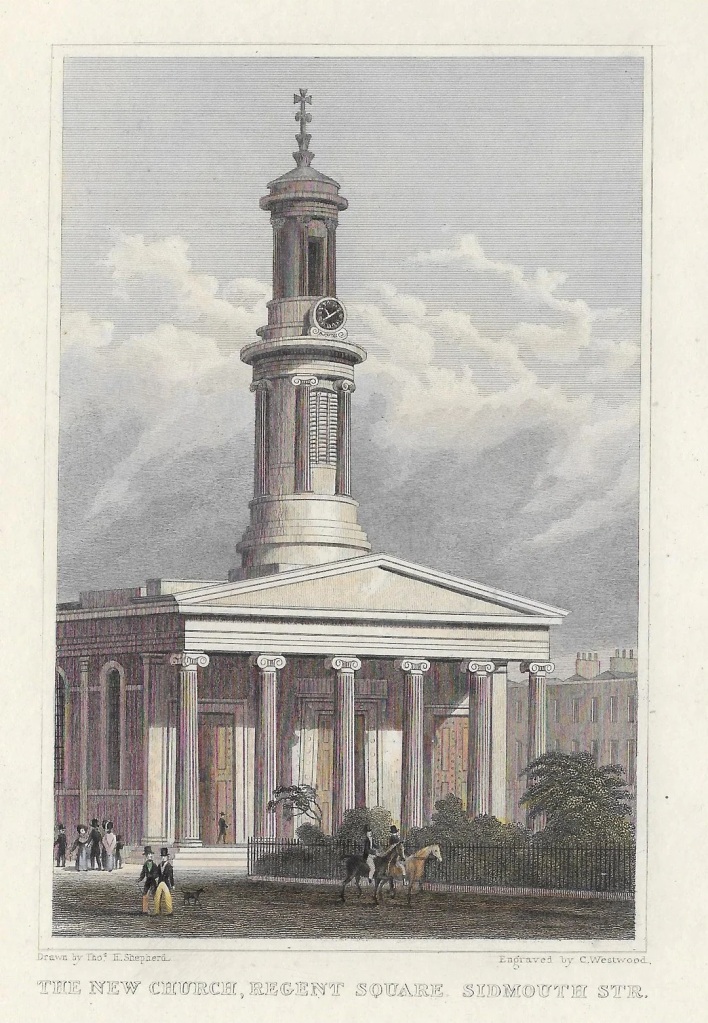
Richard, Eliza, and their Children, Walter, Henry, Eliza, Francis, Lillian, Edith, George and Charlotte, were residing at, Number 5, Park Road, Islington, Middlesex, England, on Sunday the of 2nd April 1871.
Richard was working as a Dealer in feathers.
The family had two General Servants, residing with them, Jemima Roac and Caroline Curry.
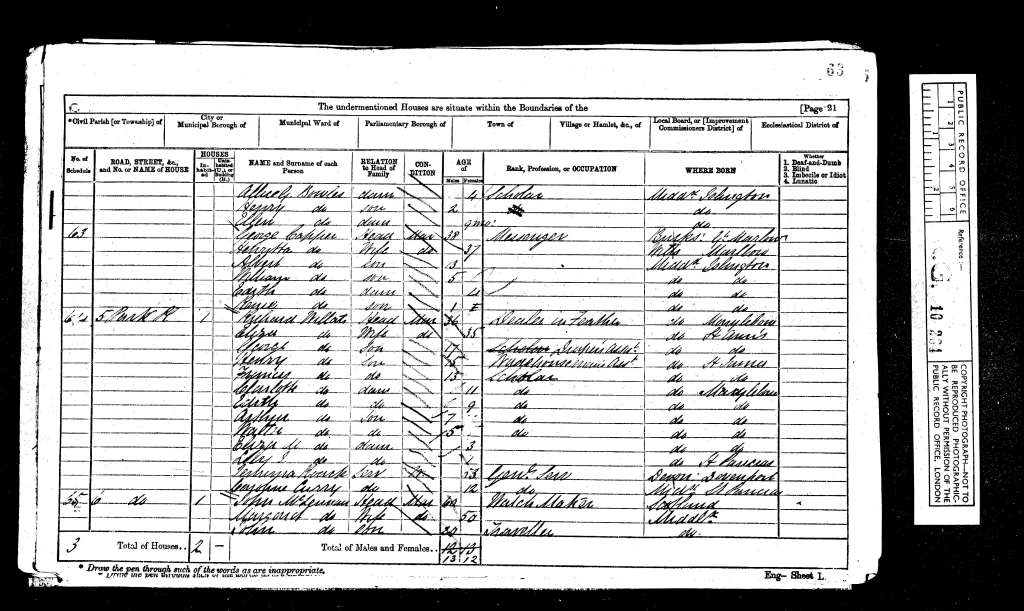
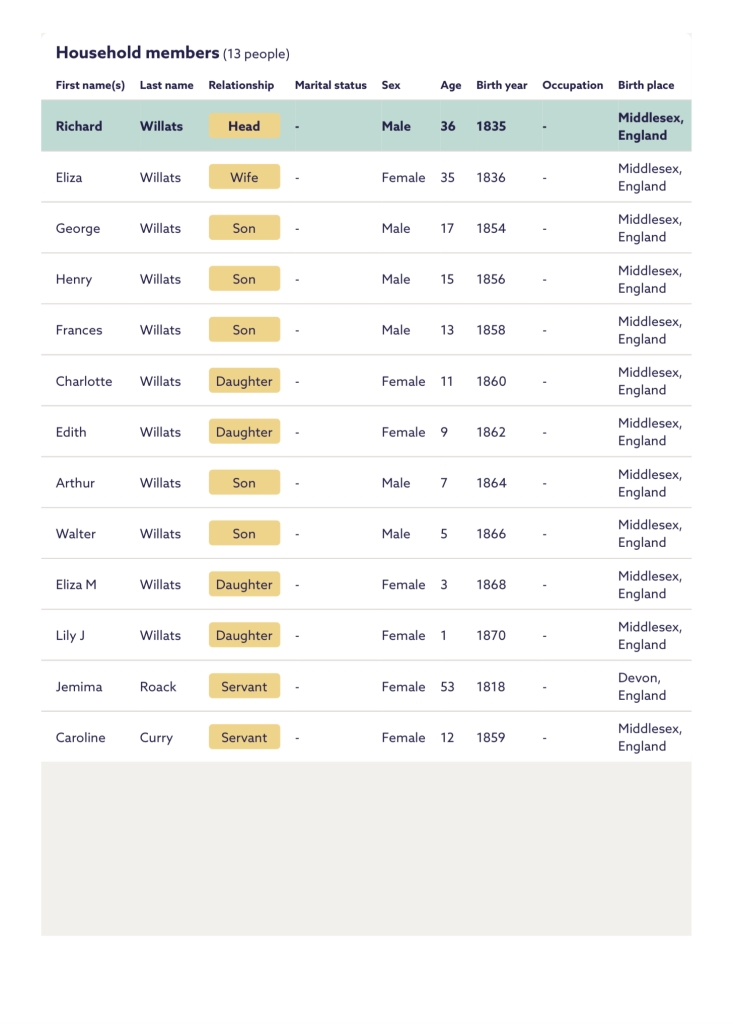
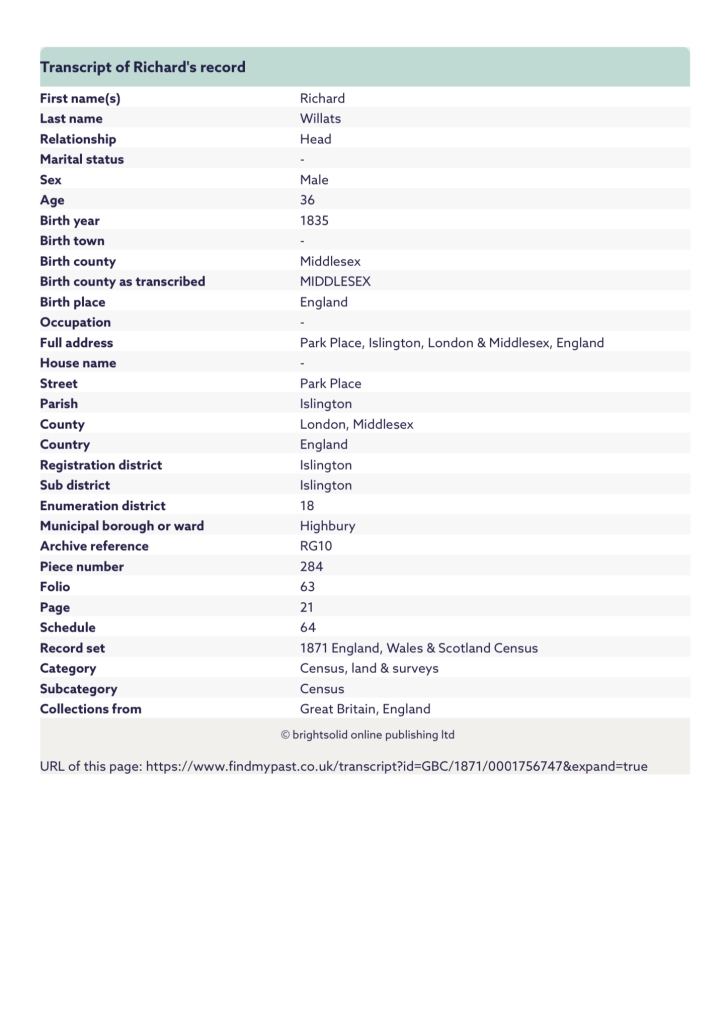
Richards father, George John Willats sadly died, on Saturday the 29th of April, 1871, at Number 53, Marshall Street, Golden Square, Westminster, London and Middlesex, England, aged 66. He died from Bronchitis. Maria Silvester of 53 Marshall Street, was present and registered his death on Thursday the 4th of May, 1871. She gave George’s occupation as a Pianoforte maker.
I do have a copy of his death certificate, which I was kindly gifted, so unfortunately I can not share it here but you can order your own copy of the certificate or a pdf certificate with the below information.

George John Willats, was laid to rest, on Wednesday the 3rd May 1891, at Pancras Cemetery, Camden, London, England, in gave E10/39 with 12 other dear souls.

Richards wife, Eliza, childbearing days were still in full flow and gave birth to hers and Richards 5th Son, Edwin Paul Willats, on Wednesday the 8th of November, 1871, at Number 5, Park Place, Highbury, Islington, Middlesex, England.
Richard gave his occupation as a Commercial Buyer and their abode as, 5 Park Place, Islington, when he registered Edwins birth on Wednesday the 20th of December, 1872.

Richard and Eliza, baptised their son, Edwin Paul Willats, on Friday the 8th of December, 1871, at St. Mary’s Church, Islington, Middlesex, England. Richards occupation was given as a Warehouse Man and their abode as 5 Park Place.

The Church of St Mary the Virgin is the historic parish church of Islington, in the Church of England Diocese of London. The present parish is a compact area centered on Upper Streetbetween Angel and Highbury Corner, bounded to the west by Liverpool Road, and to the east by Essex Road/Canonbury Road. The church is a Grade II listed building.
The churchyard was enlarged in 1793. With the rapid growth of Islington, it became full and closed for burials in 1853. It was laid out as a public garden of one and a half acres in 1885.
You can read more about St Mary’s here.

Richard and Eliza, welcomed their 5th Daughter into the world on Tuesday the 5th of May, 1874, at 5 Park Place, Highbury, East Islington, England.
They named her May Claretta Willats.
Richards gave his occupation as a, Feather Warehouseman and their abode as, 5 Park Place, Islington, when he registered May’s birth on Tuesday the 16th of June, 1874.

Richard and Eliza, baptised May Claretta, on, Sunday the 9th of August, 1874, at Christ Church, Highbury, Islington, north-west London, England.
Richard gave his occupation as a Manufacturer and their abode as, Highbury.

Christ Church, Highbury, is an Anglican church in Islington, north London, next to Highbury Fields.
The site was given by John Dawes, a local benefactor and landlord, and the church was built by Thomas Allom in a cruciform shape with a short chancel, transepts, and nave from 1847 to 1848. Bridget Cherry and Nikolaus Pevsner write that Christ Church Highbury ‘is a successful and original use of Gothic for a building on a cruciform plan with broad octagonal crossing. The cross-plan with broad nave and crossing was popular for churches in the low church tradition where an effective auditorium for the spoken word was preferred to a plan designed for an elaborate liturgy.’
Since then, several changes have been made to the church, including the addition of a balcony in 1872, and new rooms for children’s work and fellowship in 1980.

On Wednesday the 1st of September, 1875, Eliza gave birth to Percy Sidney Willats, at Richards and Eliza’s family home, Number 9, Park Place, Highbury, Islington, Middlesex, England.
Richard gave his occupation as a, Fancy Warehouseman and their abode as, Number 9, Park Place, Islington, when he registered Percy’s birth on Saturday the 9th of October, 1875, in Islington.

Richard and Eliza’s daughter, spinster Charlotte Ellen Willats married bachelor, Pierce William Crosbie, on Tuesday the 28th of March, 1876, in St Mary’s Church, Islington, Middlesex, England.
Charlotte was a minor and Pierce was of full age. Pierces occupation was given as a Gentu. They gave their residence as 9 Park Place and gave their fathers names and occupations as, Richard Henry Willats, a Warehouseman and John Crosbie a Gentu.
Their witnesses were Richard Willats and Charlottes future sister in-law Margaret Jane McLennon.
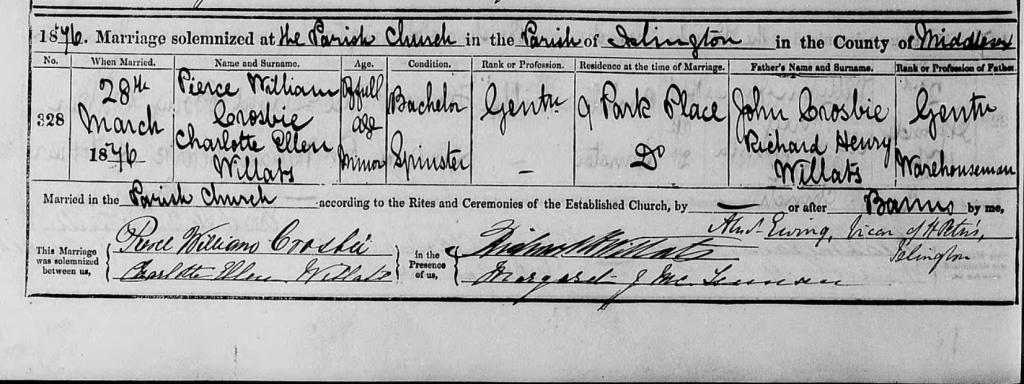
After many, many years of bearing children, Eliza gave birth to her 13th Child, a baby boy, on Thursday the 27th of February, 1877, at Number 9, Park Place, Highbury, Islington, Middlesex, England.
Richard and Eliza named him, Frederick Howard Willats.
Richards gave his occupation as a, Silk Warehouseman, and their abode as, 9 Park Place, Islington, when he registered Frederick’s birth on Saturday the 10th of March, 1877.

Richard and Eliza son, 24 year old, bachelor, publican, Henry Richard Willats married 23 year old, spinster, Amelia Etheredge, daughter of John Etheredge, on Tuesday the 30th of March, 1880 at All Saints Church, West Ham, Essex, England.
Henry gave his residence as West Ham and Amelia as, Saint Paul’s, Shadwell. They gave their fathers names and occupations as, Richard Henry Willats, a Licensed Victualler and John Etheredge, an Engineer.
Their witnesses were Charles Henry Etheredge and Alice Catherine Etheredge.

All Saints Church is a parish church in West Ham, an area in east London. It has been a Grade I listed building since 1984.

Richard and Eliza’s daughter, 19 year old, spinster, Edith Cameron Willats married 21 year old Bachelor, Edward Charlton, a Esquire, on Wednesday the 20th of October, 1880, at St Margaret Church, George Hanover Square, Westminster, London, England.
They gave their fathers names and occupations as, Richard Henry Willats, a Hotel Keeper and Henry Charlton, a Hotel Keeper.
Edith gave her residents as, 20 Australian Avenue, Barbican, Silk Street, St Giles, Westminster, London, England
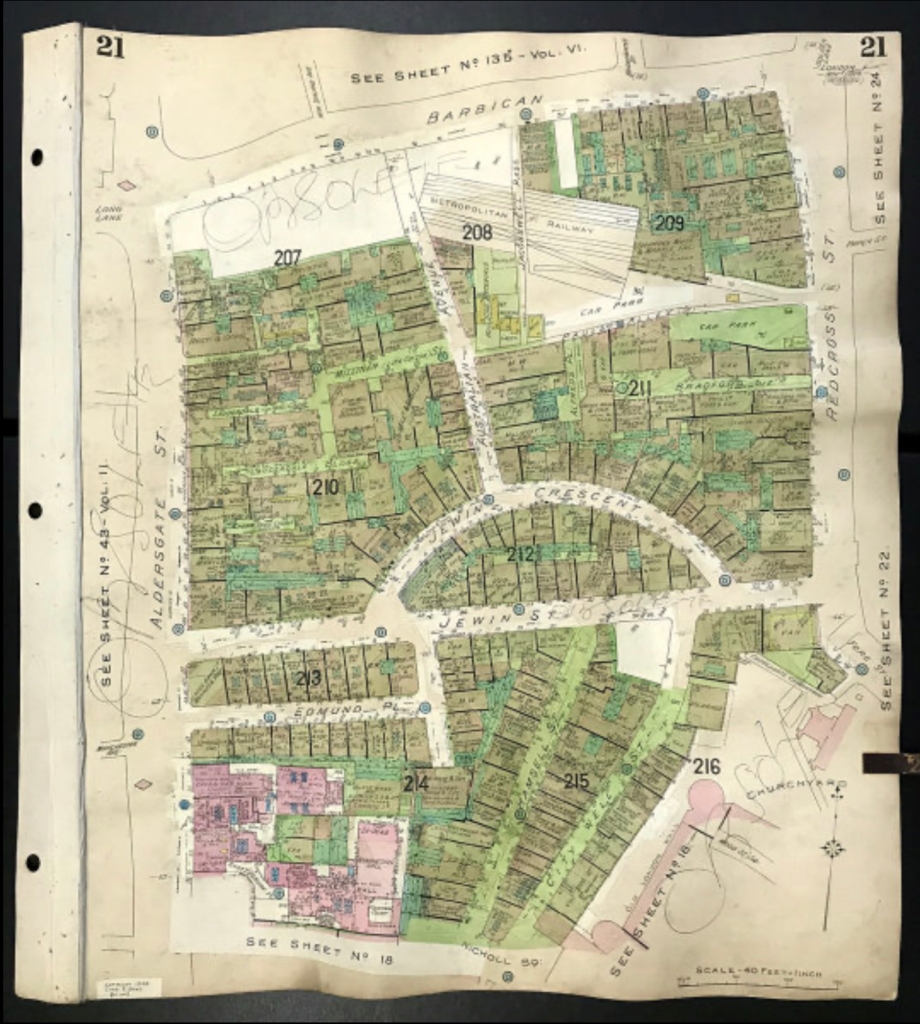
And Edward gave his as Westminster Palace Hotel.
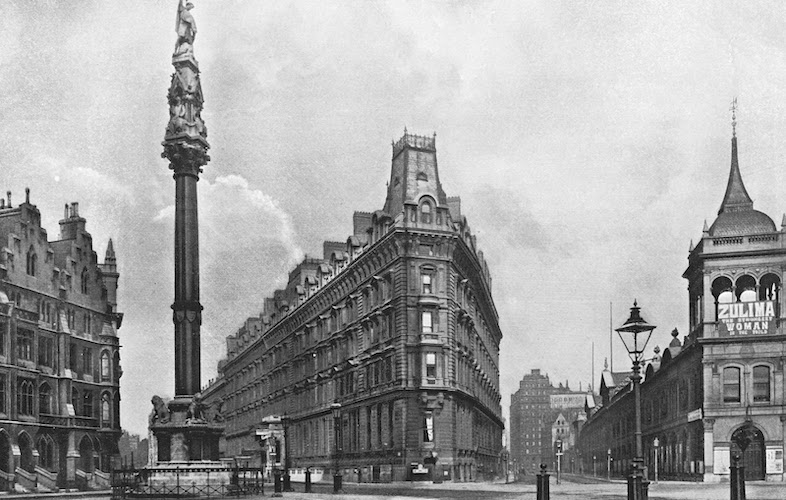
Their witnesses were, Richard Willats and William Charlton.

Richard was named in his daughter’s Edith Willats, marriage announcement on the 23rd of October, 1880 in the Pall Mall Gazette.
It’s read,
CHARLTON – WILLATS – At St. Margaret’s, West Minster Abbey, Mr Edward Charlton, of Charlton, to Edith C. daughter of Mr. Richard Willats, late of Wood Street, Oct. 20.

And 1881 census was taken on Sunday the 3rd April 1881.
The census shows, Richard, Eliza, and their children, Frank, Arthur, Eliza, Walter, Lillian, Edwin, May, and Sidney, were residing at number 61, Ambler Road, Islington, London & Middlesex, England. They had a guest named Henry Anstey staying with them.
Richard was a Publican, out of business. Frank was a General agent, Arthur a Clerk solicitors, Walter a Clerk stock exchange and Eliza, Lillian, Edwin, May and Sidney were scholars. Henry Anstey was a Enumerator (no occ).
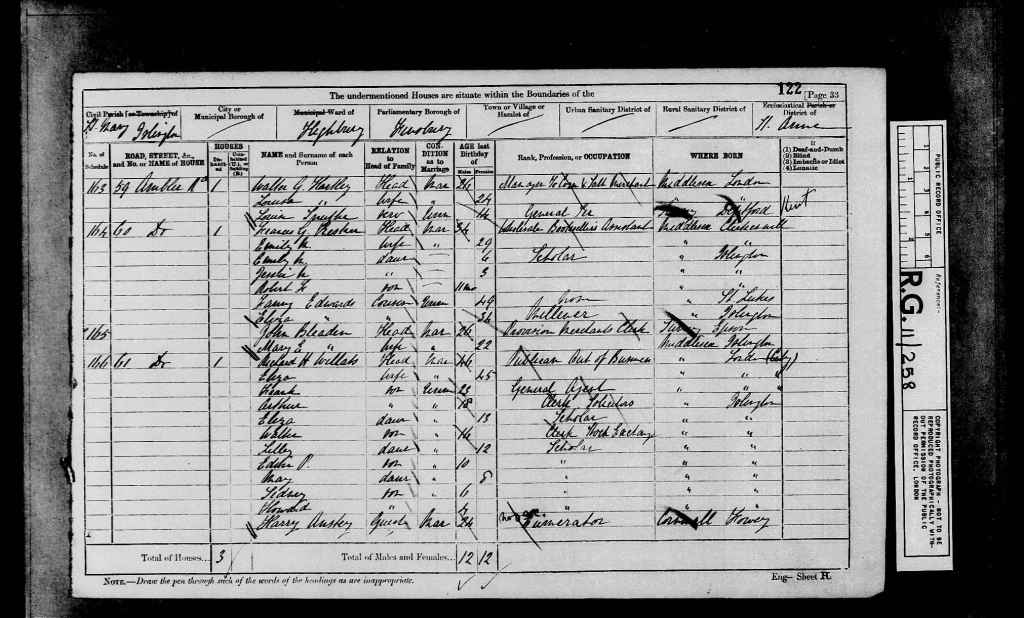



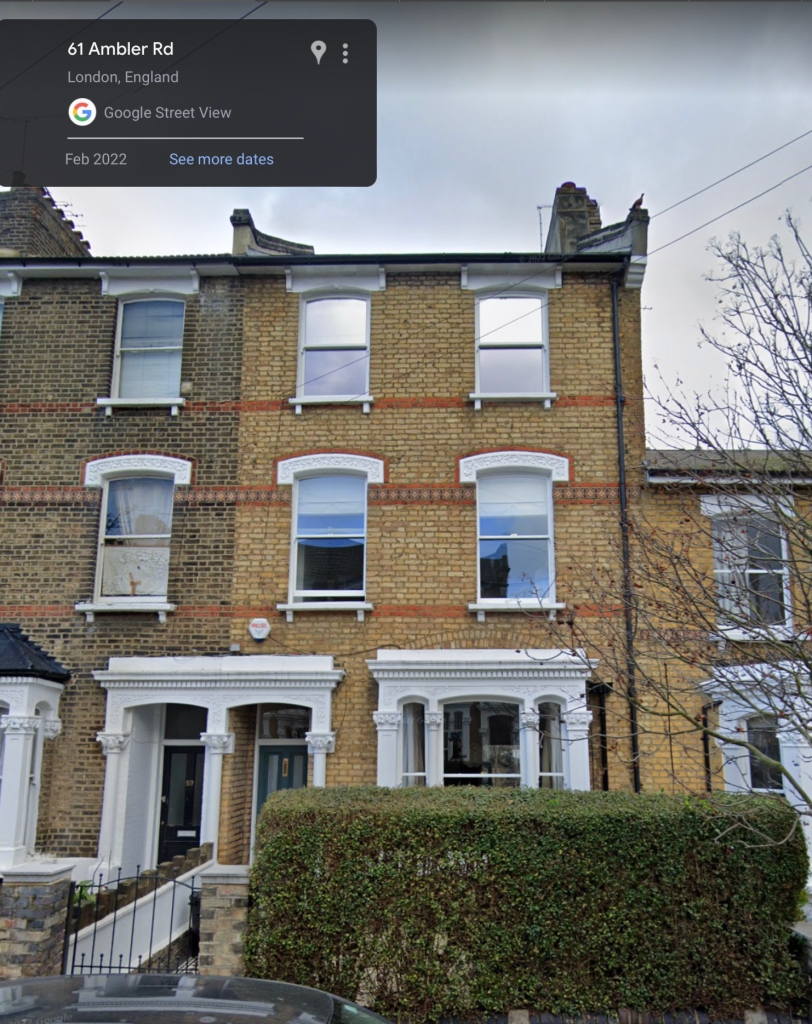
Richard’s and Eliza son, 23 year old, bachelor, Francis Montague Allen Willats married 25 year old, spinster, Margaret Jane McLennon, at St John’s Church, Hornsey, Middlesex, England, on Wednesday the on 6th of July, 1881.
Francis was working as an agent at the time of his marriage. They gave their fathers names and occupations as Richard Henry Willats, a Agent and John McLennon, a Chronometer Maker.
Francis gave his abode as, 145 Blackstock Road and Margaret gave hers as, 84, Finsbury Park Road.
Their witnesses were John McLennon and Jessie McLennon.

Richards Stepson and Eliza’s son, 29 year old, bachelor William George Willats, a Commercial Traveller, married 27 year old spinster, Alice Maria Money, at The Register Office, Islington, Middlesex, England, on Saturday the 23rd of December, 1882.
William gave his occupation as a Commercial Traveller. They gave their fathers names and occupations as, Richard Henry Willats, an Auctioneer, and John Money (deceased) a Builder.
Their witnesses were, Eliza Willats and Amelia Willats.
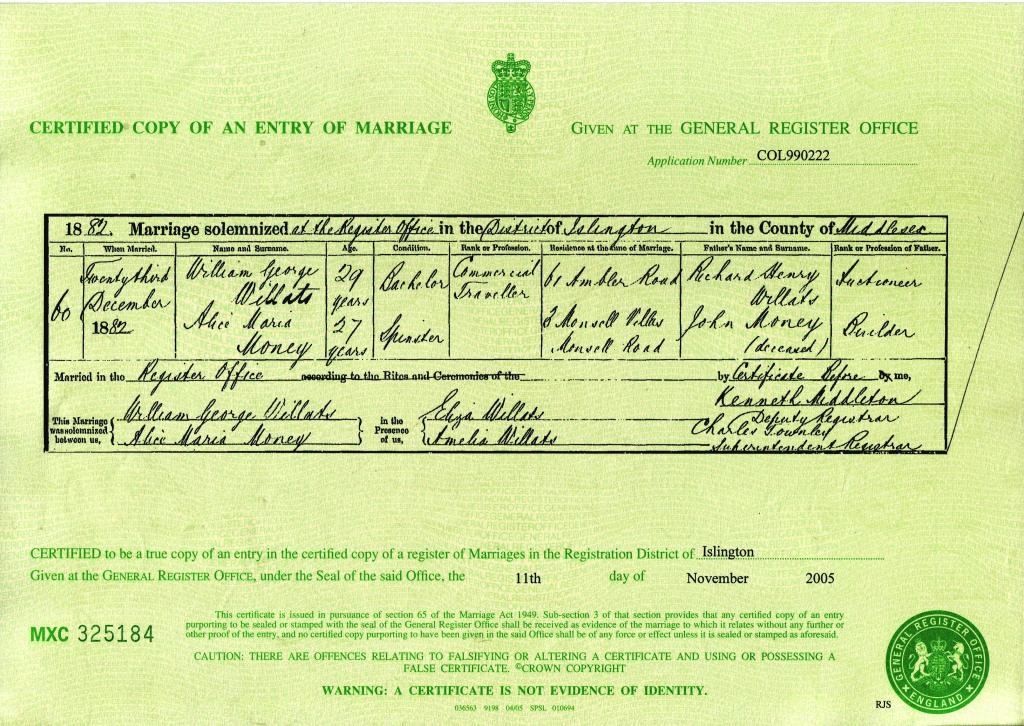
Richard, Eliza and their Children, May, Walter, Sidney, Mary, Frederick, Lily and Edwin, were residing at Number 27, Kings Road, Hornsley, Islington, Middlesex, England, on the eve of Sunday the 5th of April,1891, when the census was taken.
Richard was working as a Self Employed Survivor, Walter was a Stockbroker Clarke and Edwin was a Survivors Clarke.
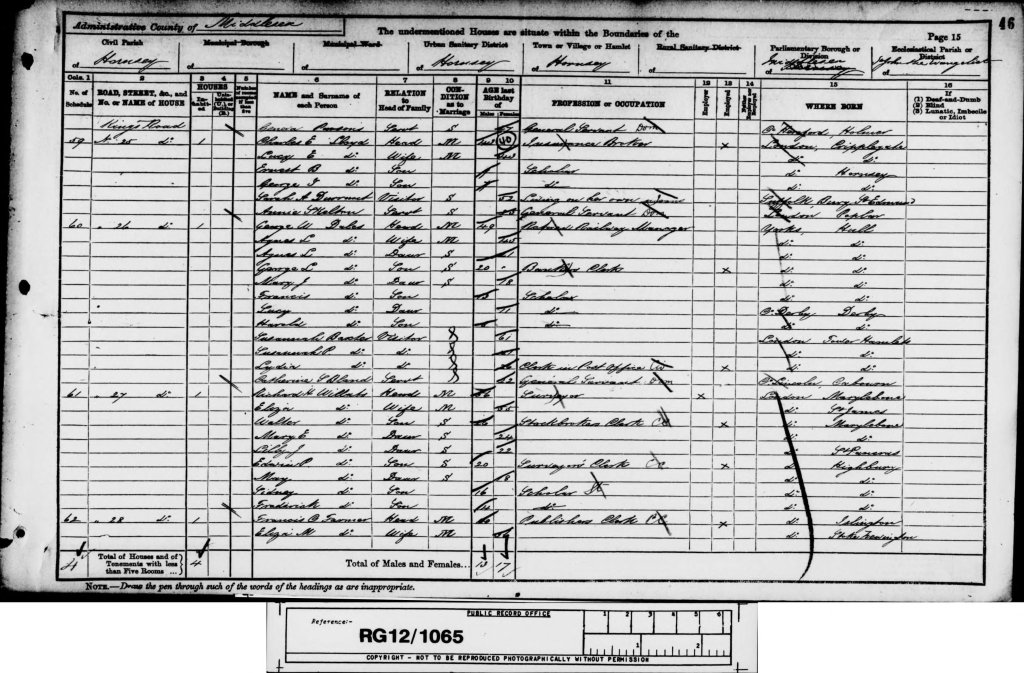
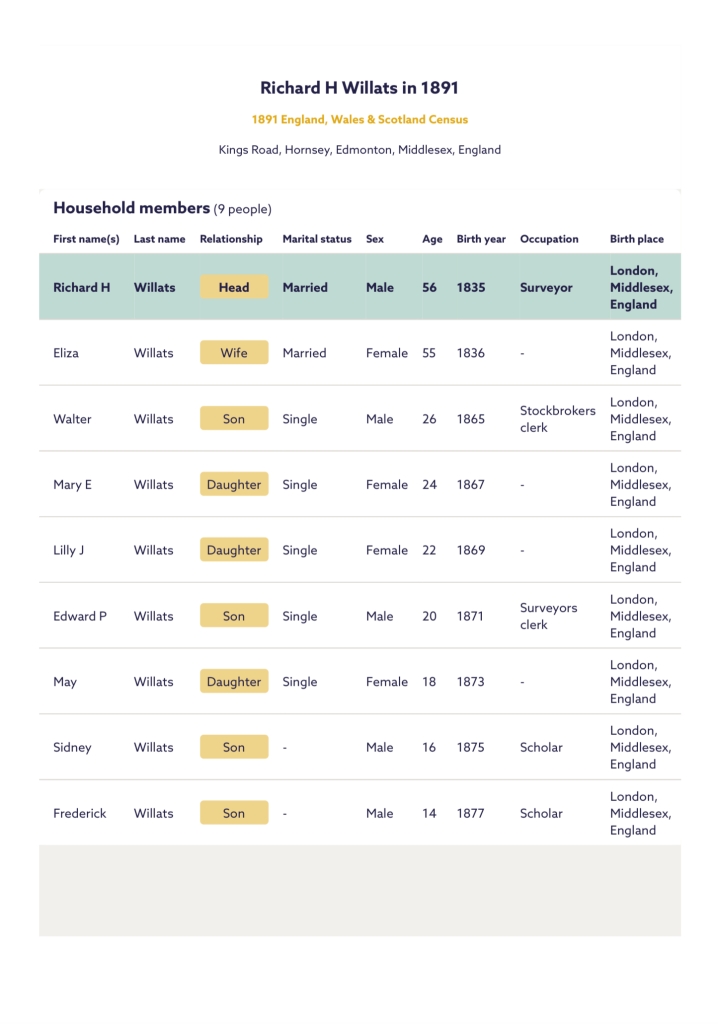
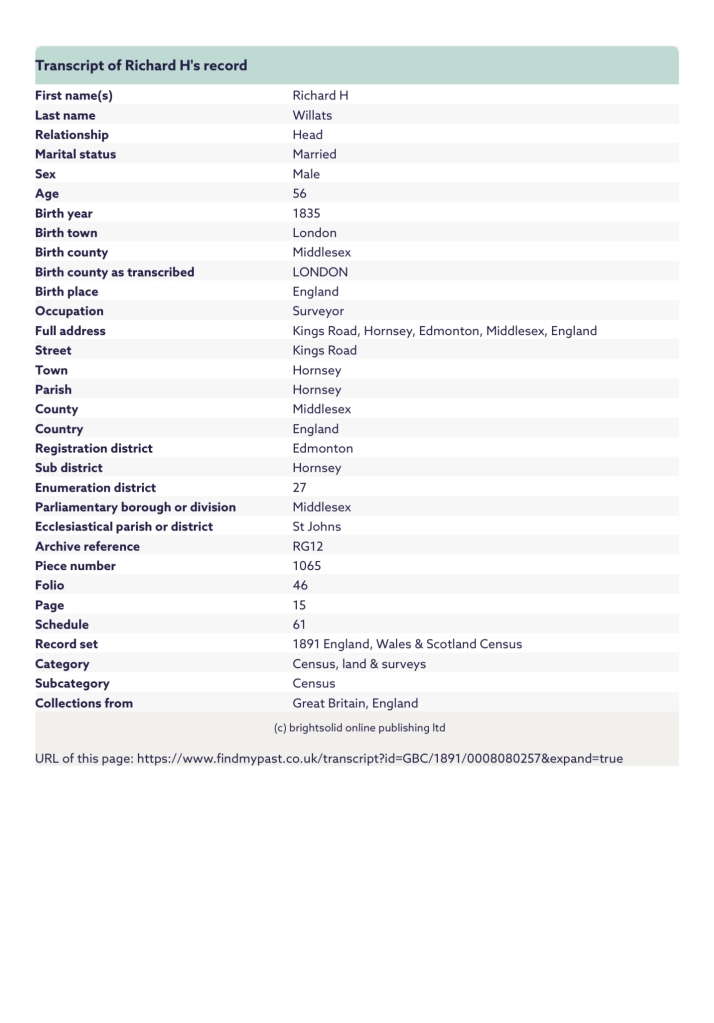
Richard’s sister, Jenny Eliza Keep nee Willats, died on Sunday the 23rd of October, 1892, at Number 97, Cottonham Road, Upper Holloway, Islington, London, England, when she was 44 years old.
Jenny died from Phthisis.
Her daughter Mary Higgs nee Keep was present and registered Jenny’s death on Monday the 24th of October, 1892. Mary stated that Jenny was the wife of Henry Arthur Keep, a commercial traveller.

Jenny was laid to rest at Islington Cemetery, Highbury, London, England, on Friday the 28th of October, 1892, in an open grave, grave reference N/3/17456, with 6 others. She was buried under the name, Jane Eliza Keep.

Heart-rendingly, Richards beloved wife, Eliza, passed away on Friday the 23rd of November, 1894, at Number 27, Kings Road, South Hornsey, Edmonton, Middlesex, England, when she was 59 years old.
Eliza died from, disease of valves of the heart two years nine months and dropsy.
Her daughter Edith Charlton of Number 27, Kings Road, South Hornsey, was present and registered Eliza’s death on Monday the 26th of November, 1894.
Edith gave her father Richards occupation as an Auctioneer and Surveyor.

When Eliza died Richard Henry, purchased 2 graves in Abney Park Cemetery, which was then the beautiful garden of a big house turned into a private cemetery.
Each grave cost, 3 guineas and took six interments.
The Willats family laid Eliza to rest, in one of the purchased graves at, Ebney Park Cemetery, Stoke Newington, Middlesex, England, on Thursday the 29th of November, 1894, in D06, Grave 092431.
Her abode was given as, Number 27, Kings Road, Brownswood Park, South Hornsey.

My mind cannot comprehend the pain Richard must have been in at losing the love of his life Eliza.
How does one get over such a loss?
The story behind the creation of Abney Park and the other graveyards of The Magnificent Seven is that in the early 1800s, London’s rapid population growth meant there was no more room in inner-city burial grounds. There was no more space to bury the dead, and bodies were piling up. Pretty horrible, right?
Parliament passed a bill to encourage the establishment of new, private cemeteries, within ten years, seven had been established.
On a lighter note, the site Abney Park sits on was formed from two estates of Fleetwood House and Abney House, the latter of which was the home of renowned non-conformist and hymn writer Isaac Watts.
As a result, it became a prominent burial ground for dissenters—those who practice outside of the established church.
It was also laid out as an arboretum, with over 2,500 species of plants and trees including oaks, pines and thorns inside.
By the 1970s, the site had fallen into disrepair and was abandoned. Hackney Borough Council took it over, and the ramshackle nature remained which gives it the spooky, and charming atmosphere that lures people in today.
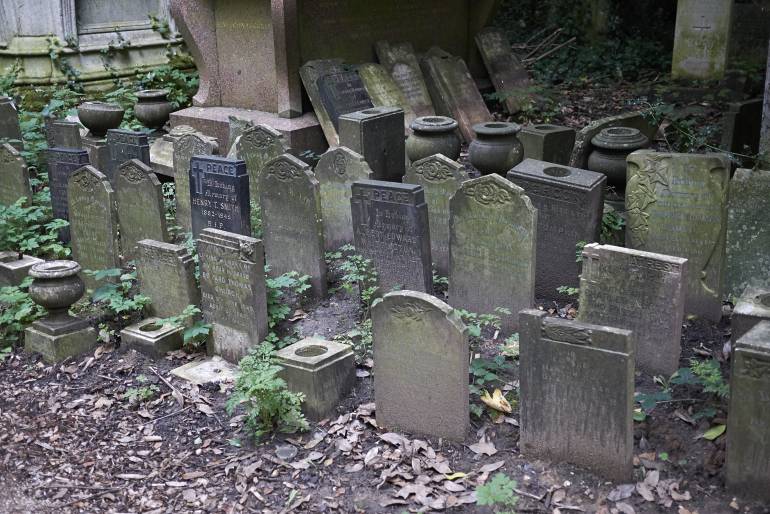
Abney Park itself started off as a picturesque parkland, laid out by Lady Mary Abney and Dr Isaac Watts, along with their neighbours, the Hartopps, in the early 18th century.
It wasn’t until 1840 that it was destined to become one of London’s cemeteries, a public arboretum, and an education centre.
Dr Isaac Watts was famously a non-conformist – which means that he practised religion outside of the established church (or simply had no faith), which was a big no no at the time.
This association led to Abney Park becoming a burial ground for non-conformists – but, although the chapel was non-denominational, the park was open to everyone regardless of their religious beliefs.
Today, as well as being a graveyard, Abney Park is a popular local nature reserve. Boasting more than 13 acres of lush woodland, Abney Park has around 200 trees dating back to the Victorian era and plenty more from the 19th century.
As the only mature mixed woodland in North Hackney, Abney Park is also home to some pretty cool wildlife including the Sparrowhawk and Tawny Owl, around a dozen Great Spotted Woodpeckers, and (to many people’s dismay) parakeets – you can read all about their controversy here.
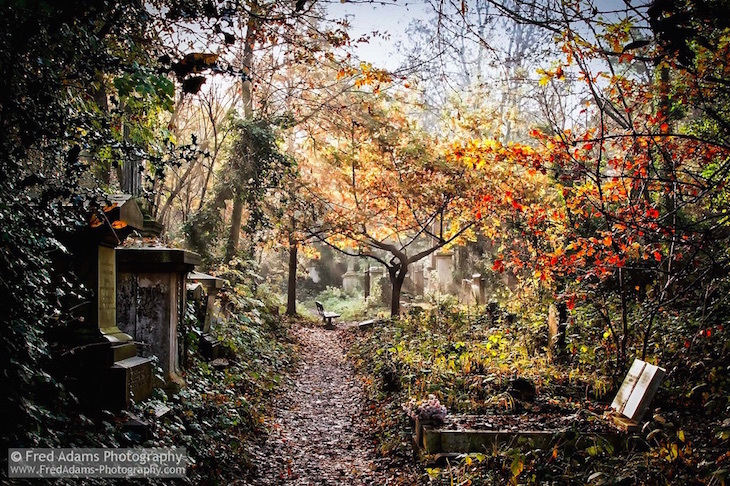
Arboricultural and ecological consultant Russell Miller has studied ecology at Abney Park Cemetery for over 25 years, and he offers guided tours and fascinating talks relating to the unusual wildlife and fauna that can be found at Abney.
Hackney Council has also been putting in plenty of work to restore the graves and conserve Abney Park Cemetery as a significant area of architecture and ecology.
In recent years, this has meant that the Williams sarcophagus has been repaired, Sir Isaac Watt’s monument has been restored, and plenty of memorials have been deep cleaned.
A £5m project to improve Abney Park Cemetery in Stoke Newington, which will bring its chapel back into use and create a new café at its main entrance has begun.
The work, £4.4m of which is funded by the National Lottery Heritage Fund and The National Lottery Community Fund, will also see a new accessible entrance created on Stoke Newington Church Street.
Hackney Council will contribute an additional £710,000 to the National Lottery funding, which will bring total investment to over £5m. Abney Park Trust Charityorganisation will also contribute to the improvement project through its volunteers and local donations.
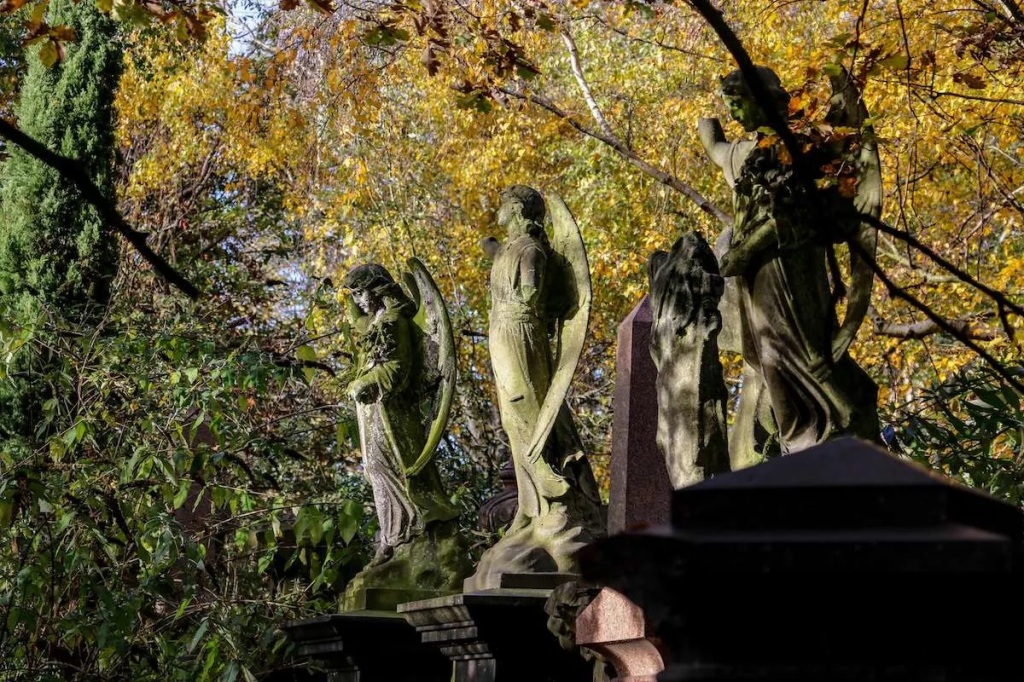
Richard and Eliza’s Daughter, 28 year old, spinster,Mary Eliza Willats, married 48 year old Widower, wine merchant, Benjamin Beach, on Thursday the 11th July 1895, at St John’s Church, Highbury, Islington, Middlesex, England.
Mary gave her residence as, 27 Kings Road and Benjamins as . (If you can work it out, please let me know.)
They gave their fathers names and occupations as, Richard Beach (deceased) a Brewer and Richard Henry Willats, a Gentleman.
Their witnesses were, her father Richard Henry Willats and Charles Watson. Eliza used the name Mary Eliza Willats.

On the 05 October 1896, Richard was mentioned in an article in the – Echo (London) Newspaper.
It reads,
At Cambridge on Saturday Richard Henry Willats, auctioneer, of Holborn-viaduct, was committed for trail on bail on a charge of, Perjury preferred by Augustus Miriam, barrister, who last October was sentenced to nine months’ imprisonment on a charge of obtaining money by false pretences on which occasion Willats gave evidence against him.
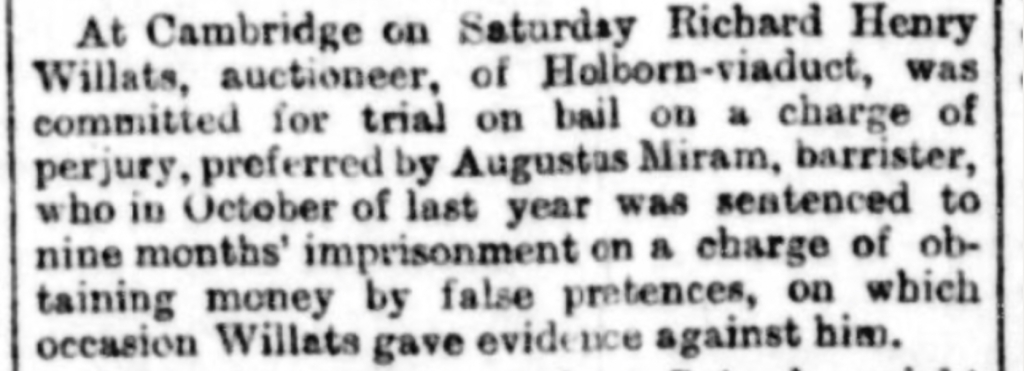
Richard was also mentioned in the Western Times Newpaper, on the 06th of October, 1896.
It reads,
SERIOUS CHARGE.
At Cambridge on Saturday Richard Henry Willats, auctioneer, of London, was committed for trail on bail on a charge of, Perjury preferred by Augustus Miriam, barrister, who last October was sentenced to nine months’ imprisonment on a charge of obtaining money by false pretences on which occasion Willats gave evidence against him.

And Richard was named in the, Saffron Walden Weekly News, on the 30th of October, 1896.

Richards Stepson, Eliza’s son, 44 year old, Estate Bailiff, William George Willats, died on Sunday the 14th of February, 1897, at 44 Gillespie Road, Islington, Middlesex, England.
He died from Cardial Haemorrhage Corona Syncope. Williams Sister, Charlotte Ellen Crosbie, of, 132 Wilberforce Road, Finsbury Park, was present and registered his death on Tuesday the 16th of February, 1897.

The Willats family laid William Willats to rest at Abney Park Cemetery, Stoke Newington, Hackney, London, England on Thursday the 18th of February, 1897, in grave D06 092431 with Eliza Willats, Francis Paul Willats, Richard Henry Willats and Percy Sidney Willats.

Richard and Eliza’s daughter Lillian Jenny Willats married William Alexander Willats, on Saturday the 15th of July, 1899, at St. John’s Church, Highbury, Islington, Middlesex, England.
Lillian was a 29 year old spinster and William was a 31 year old bachelor, whom was working as a commercial. (I assume that means commercial traveller?) They gave their fathers names and occupations as, Richard Henry Willats, an auctioneer and William Neilson, a commercial.
Lillian was residing at 27 Kings Road, Brownhill Park and William at Madeira Avenue, Worthing, Sussex, at the time of their marriage.
Their witnesses were, brother in-law, Benjamin Beach and her cousin, Amina Charlton.

Richard and Eliza’s son, 28 year old Bachelor Edwin Paul Willats married 19 year old, spinster, Nellie Elizabeth High on Saturday the 7th of July, 1900, at All Hallows, Tottenham, Edmonton, Middlesex, England. Their wit We’re Walter James Willats and Amelia Ellen Willats.
Their fathers names and occupations were given as Richard Henry Willats, a surveyor and James High, a Cabinet Maker.
As you can see the certificate is near on impossible to transcribe, so I have given you the information I can work out, sorry.

All Hallows is an Anglican church in Tottenham, North London. It is one of the oldest buildings in the London Borough of Haringey, having been built as All Saints’ Church in the 12th century, then re-dedicated as All Hallows in the 15th century. It stands adjacent to Bruce Castle and Tottenham Cemetery. It is reputed to have been given to Tottenham by King David I of Scotland, strengthening its connection with the Bruce family who were owners of Bruce Castle. The church is part of the Diocese of London and its clergy have included William Bedwell (from 1607), the devotional writer Edward Sparke (1667–1693), and John Howard Churchill, later Dean of Carlisle. The church was restored between 1875 and 1877 by the architect William Butterfield. It has been painted many times, including by William Ellis, John Preston Neale, William Henry Prior, John Thomas Smith, Jean Baptiste Claude Chatelain and John Constable.

The 1901 census was held on Sunday the 31st March.
It shows, Richard and his children, Percy, Mary and Edith (Charlton nee Willats), and granddaughter Emma Charlton as well as their maid, Florence Giles, were residing at, 27, Kings Road, Stoke Newington, Hackney, London & Middlesex, England.
Richard was working as a Surveyor and Percy was a, Clerk surveyor.
Richard was listed under the name, Killmod H Willats. I have reported the error so hopefully it will be changed so others can find him easily.


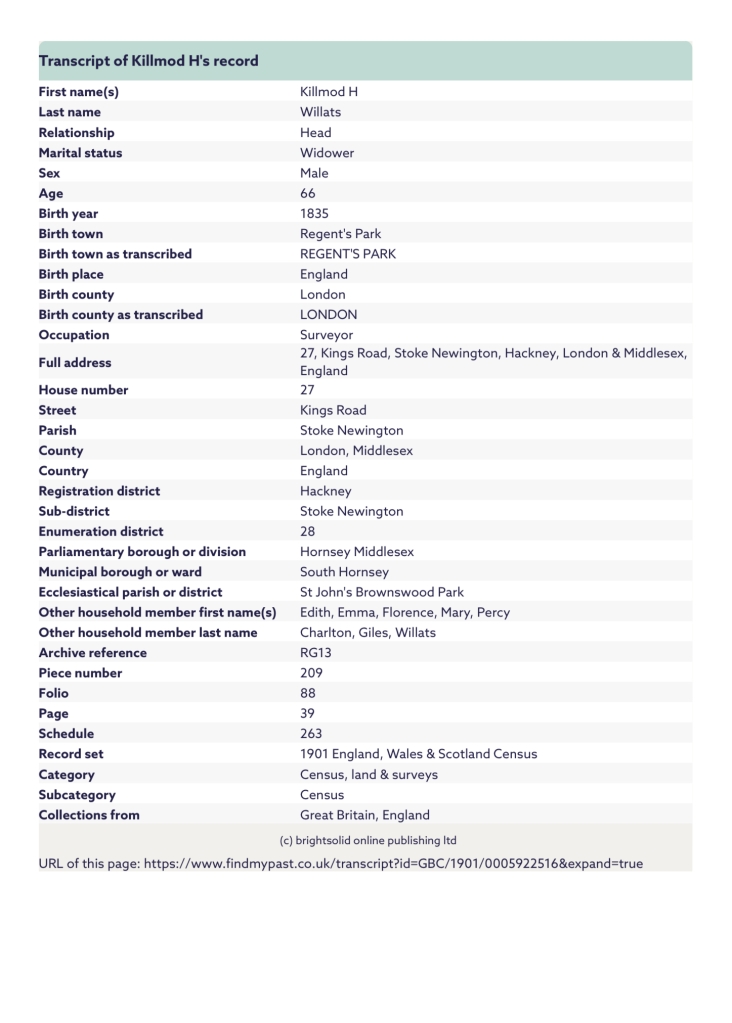
Richard was a witness at the Old Bailey court on the 21st of July 1902.
What an awful day it was for Richard, not only was he a witness but heartbreaking while he was possibly at court giving his testimony, his daughter sadly passed away.
Eliza Mary Beach nee Willats died on Monday the 21st of July 1902, at Beach Court, Upper Deals, Eastry, Kent, England, at the awfully young age of 35 years.
Eliza died from Pneumonia and exhaustion.
Edith Cameron Charlton nee Willats, Richards daughter and Eliza sister, was present and registered her death on the same day, Monday the 21st of July 1902.
Edith stated the Eliza was the wife of Benjamin Beach, giving his profession as, independent means.
Eliza’s death was registered under the name Mary Eliza Beach.

Eliza Mary Beach nee Willats was laid to rest, on Thursday the 24th July, 1902, at St Peter in Thanet, Kent, England.

Thankfully a joyful occasion wasn’t too far away.
Richard and Eliza’s daughter, 28 year old, spinster, May Claretta Willats married 20 year old, architectural florist, bachelor, George Frederick Champion on Saturday the 4th of April 1903, at St. John’s Church, Highbury Vale, Islington, London, England.
May gave her residence as, 21 Montague Road and George as, 194 Green Lands.
They gave their father’s names and occupations, as George Frederick Champion, an architectural florist and Richard Henry Willats an Estate Agent.
Their witnesses were, George Frederick Champion and Mays niece, Amina Eliza Catherine Charlton.

Richard and Eliza’s son, 26 year old bachelor, surveyor, Frederick Howard Willats, married 24 year old spinster Maud May Beach, on Saturday the 19th September 1903, at St. John’s Church, Highbury Vale, Islington, London, England.
Frederick gave his abode as, 27 Kings Road and Maud graves hers as, 16 Orchard Road, St. Margarets on Thames.
They gave their fathers names and occupations, as Richard Henry Willats, estate agent, and Walter Beach (deceased), a Gentleman.
Their witnesses were her brother, Persey Sidney Willats and his niece, Amina Eliza Catherine Charlton.

Mournfully Richard was named in a newspaper paper article,about the suicide of his son in-law, Pearce Crosbie. The article was printed on the 12 October 1907 in the Hampstead & Highgate Express.

The 1911 census was taken on Sunday 2nd April 1911. It shows Richard, his daughter Charlotte Ellen Crosbie nee Willats whom was now a widow, residing at, Number 99, Lordship Road, Stoke Newington North, Stoke Newington, London & Middlesex, England, an 11 room dwelling.
They had a friend called Ellen Smart and a servant named Agnes Clara Wicks, residing with them.
Richard was working as a Surveyor.
Richard had filled out the section under Infirmity as “None Thank God.” 😂
Richard states that he was married for 41 years, had 13 children of which 11 were still living and two had died. Charlotte had been married for 30 years and had no children. Agnes was a widow and had been married under a year and had one living child. Ellen had never been married and had no children.
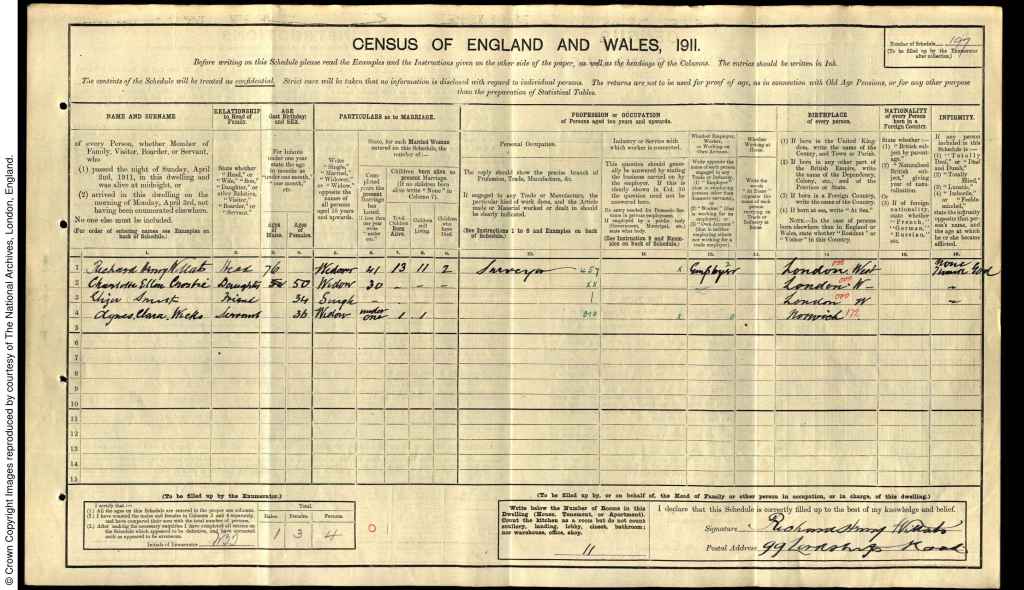


Richard and Eliza’s daughter, 43 year old, widow, Lillian Jenny Neilson nee Willats, married 41 year old, bachelor, George Campbell Ferris, on the 23rd of October 1915, at The Register Office, Islington, London, England. Jenny gave her abode as, 35, Yesbury Road and George gave his as 87 Winchester Street and his occupation as a commercial clark. Their parents were named as, George Coell Ferris a commercial traveler (deceased) and Richard Henry Willats, an Auctioneer. Their witnesses were, Claude Eayes and J E Bailie.

From the 1880-1984 British Phone Books, we know that Richard was residing at, 21 Charterhouse, Holborn and his son, Henry Richard, was either residing or working out of, 25 Holborn Viaduct, London England, now known as Fitz-Eylwin House, 25 Holborn Viaduct, London EC1A 2BP, in 1916.

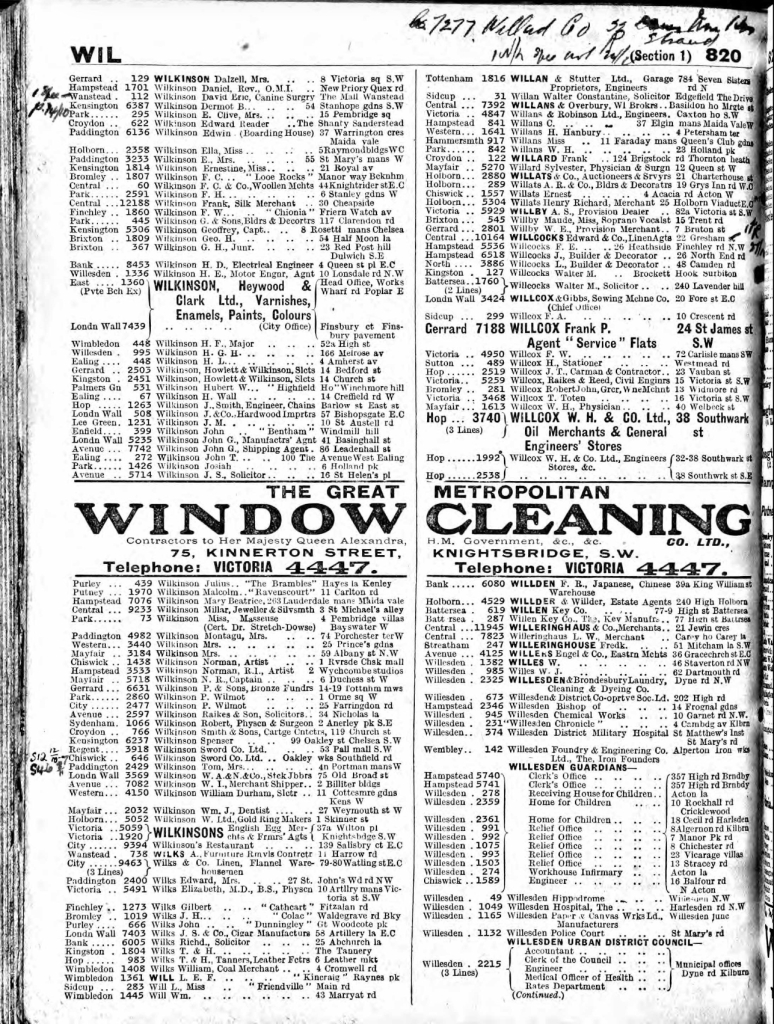
Richard was named on his son, Arthur C Willats, United States Of America, passport application on Thursday the 1st of May, 1919.
It’s states that Richard was born in England and was residing in London.

Richard and Eliza’s son, 48 year old, a Architects Draftsman, Edwin Paul Willats, sadly passed away, on Monday the 5th of July 1920, at Number 52, Grove Park Road, Tottenham, Edmonton, Middlesex, England.
Edwin died from Pulmonary Tuberculosis and Hemoptysis cardiac failure. Certificated by Gordon Miller mb. No post-mortem was taken.
Edwins sister in-law, Amelia Ellen Willats nee High, of 132, Landsdowne Road, Tottenham,

was present and registered Edwins death on Tuesday the 6th of July 1920, in Edmonton.

The Willats family and friends laid Edwin Paul Willats, to rest at, Abney Park Cemetery, Stoke Newington, Hackney, London, England, in Section, D06, Index 7S03, on Saturday the 10th of July, 1920.
He was buried with other family members.

Heartbreakingly death continued to plague the family as Richard and Eliza’s son, 63 year old, Insurance Manager, Francis Montague Allan Willats, sadly passed away on Sunday the 19th of September 1920, at Wymondley Heathgate, Hendon, Middlesex, England. He died from Chronic interstitial hepatitis several years, certified by H. Stedman. No post-mortem was taken.
Francis’s son, Allen Montague Willats was present and registered his death on Tuesday the 22nd September, 1920, in Hendon.

Richard and family laid Francis Montague Willats, to rest, on Tuesday the 21st September 1920, at Highgate Cemetery, Camden, London, England, grave reference /40479. He was buried with 7 others, Frances Jessie Willats, buried 16th September 1976. Allan Montague Willats, buried 2nd March 1968. Dorothy Beaumont Willats, buried 9th April 1965. Margaret Eliza Craddock, buried 1st January 1961. David Allan Willats, buried 5th February 1948. Margaret Jane Willats, 25th October 1937 and Horace Lennan Willats, buried 19th December 1916.

On Sunday the 19th of June, 1921, Richard was residing at, 34, Portsdown Road, London, Paddington, London & Middlesex, England, with his daughter Charlotte Ellen Garbie and his niece, Eliza Smith.
Richards place of birth was given as Ireland, S Pannas.
His occupation was given as Late Surveyor (No Occupied).
Richard was 86 years and 10 months old.
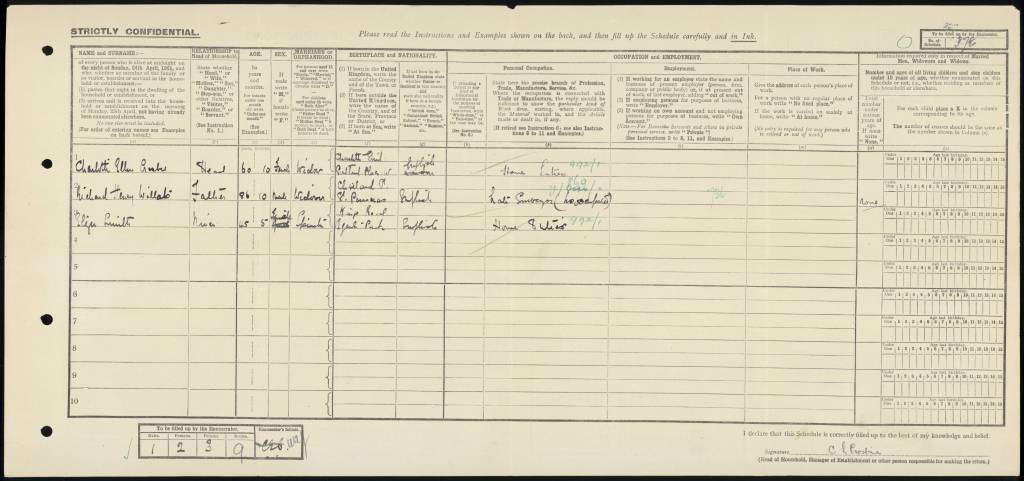
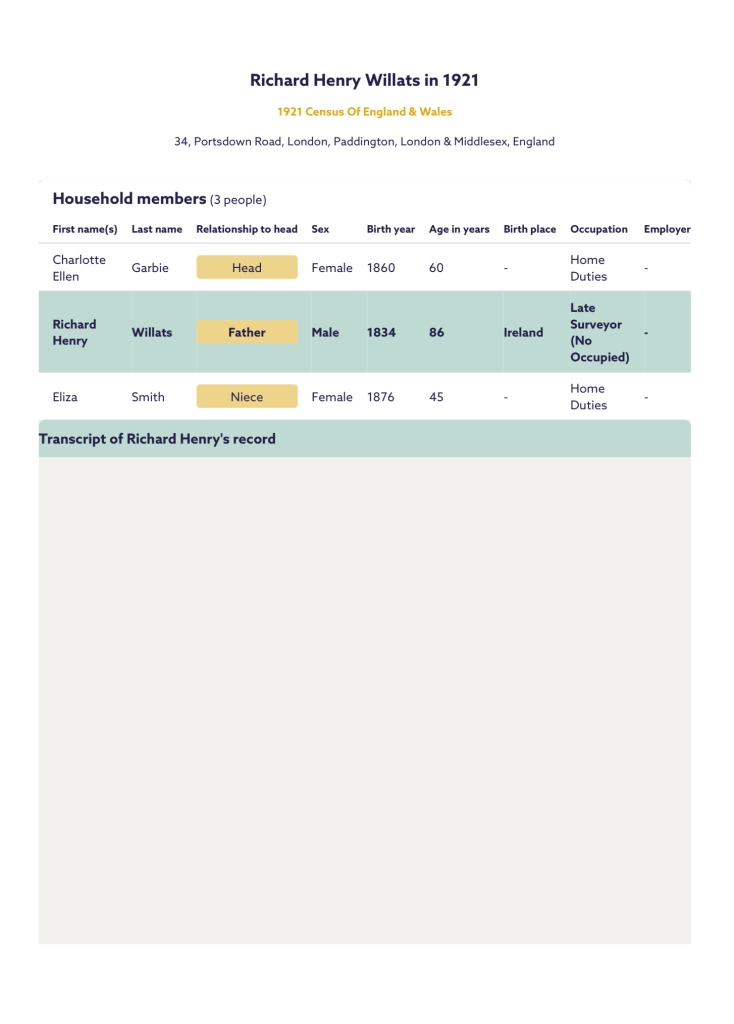


Richards brother, 86 Year old, retired Jewellery Marchant, James William Willats, whom was known as William James, sadly passed away, on Monday the 23rd of January 1922, at Number 37, Lansdowne Crescent, Kensington, London, England.

He died from Arteriosclerosis emphysema of lungs, mitral Disease very many years and Influenza, 1 month. Certified by R Williams, M.D. His daughter, Beatrice Emily Pocock nee Willats, was present and registered James death on Tuesday the 24th of January 1922, in Hendon.
James death was registered in the name, William James Willats.

Richard and family laid, James William Willats, to rest at, Kensal Green Cemetery, Kensington, London, England, on Thursday the 26th of January, 1922.
He was buried under the name William J Willats.
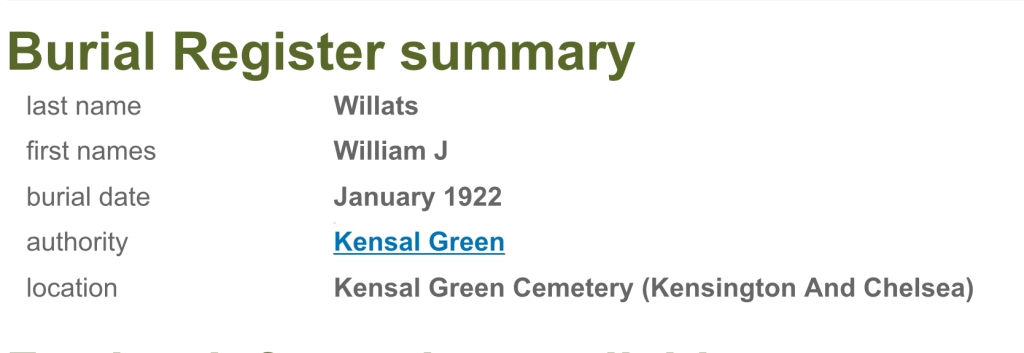
Kensal Green Cemetery is a cemetery in the Kensal Greenarea of Queens Park in the Royal Borough of Kensington and Chelsea in London, England. Inspired by Père Lachaise Cemetery in Paris, it was founded by the barrister George Frederick Carden. The cemetery opened in 1833 and comprises 72 acres (29 ha) of grounds, including two conservation areas, adjoining a canal. The cemetery is home to at least 33 species of bird and other wildlife. This distinctive cemetery has memorials ranging from large mausoleums housing the rich and famous to many distinctive smaller graves and includes special areas dedicated to the very young. It has three chapels and serves all faiths. It is one of the Magnificent Seven cemeteries in London.
The cemetery was immortalised in the lines of G. K. Chesterton‘s poem “The Rolling English Road” from his book The Flying Inn.
For there is good news yet to hear and fine things to be seen;
Before we go to Paradise by way of Kensal Green.
Despite its Grecian-style buildings, the cemetery is primarily Gothic in character, due to the high number of private Gothic monuments. Due to this atmosphere, the cemetery was the chosen location of several scenes in movies, notably in Theatre of Blood.
The cemetery is listed Grade I on the Register of Historic Parks and Gardens. It remains in use.

More death followed when Richard and Eliza’s son, 67 year old, former Director of Limited Companies, Henry Richard Willats, passed away on Monday the 27th of November 1922, at Number 23, Barnmead Road, Beckenham, Bromley, Kent, England.
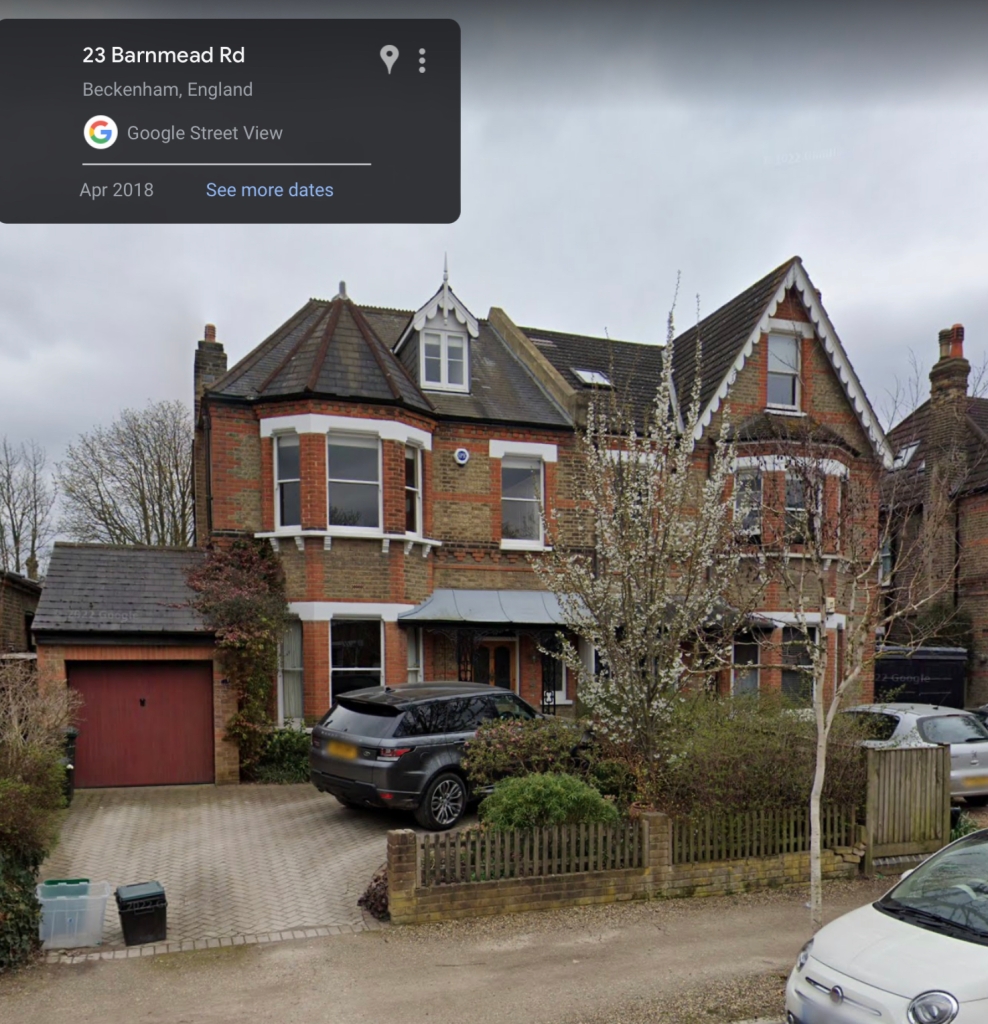
Henry died from Chronic Naphritis 10 years and Cardinal Failure 6 months. Certified by Georgia R Stilwell M.B.
Henry’s brother, Walter James Willats, of 132 Lansdowne Road, was in attendance and registered Henry’s death on the same day as his death, Monday the 27th of November, 1922, in Bromley.

The Willats family laid, Henry Richard Willats to rest, on Friday the 1st of December, 1922, at Abney Park Cemetery, Stoke Newington, Middlesex, England.
His was buried in a family grave and was buried with Baby Thornton, Florence Jose Western nee Willats, Harry Ashley Willats, William Western Thornton, and Amelia Willats.

Sadly this is where Richard Henry Willats life came to an end, as on Thursday the 22nd of November, 1923, Richard died at, 34B Portsdown Road, Paddington, London, England, when he was 89 years old.

Richard died from, Bronchitis and Senility, the state of being senile, down to the weakness or mental infirmity of old age.
Richards son, Percy Sidney Willats of 27 Kings Road, Finsbury Park, was present and registered his fathers death on Saturday the 24th of November, 1923.
Percy, gave Richards occupation as a retired, auctioneer and surveyor.

Richard was laid to rest, on Tuesday the 27th of November, 1923, at Abney Park Cemetery, Stoke Newington, Hackney, London, England, in grave D06 092431 with his wife, Eliza Willats nee Cameron, his sons Francis Paul Willats and Percy Sidney Willats. And his Stepson William George Willats. (My 3rd Great-Grandfather.)

There are 22 Willats buried at Abney Park Cemetery.
Richards probate was granted on the 6th March 1924, in London, England.
It reads,
WILLATS Richard Henry of 34B Portsdown Road, Maida Vale,
Middlesex and of 25 Holborn Viaduct London died 22 November
1923 at 34B Portsdown Road Probate London 6 March to
Walter James Willats stock broker Percy Sidney Willats
and Frederick Howard Willats surveyors.
Effects £741. Resworn £1011.

I have tried to order Richards last will and testament but unfortunately even though I have all information needed, I don’t seem to be able to order it. I will of course keep trying and will add it here if and when I can purchase a copy.
You may have noticed I have missed out a few of Richard’s children marriages and deaths. I do have their information but thought it best not to include these until I have all the official documentation, including their certificates.
I can tell you Arthur married twice in Buffalo, New York, America. I am trying my hardest to get the certificates for his marriages.
I am hoping to do a new series about all the Willats family, especially the children of Eliza Cameron and George and Richard Willats, as many of them had absolutely fascinating lives.
I’m sure you can imagine this isn’t a quick, cheap challenge I’ve set myself, so please bear with me, I promise to document their lives as soon as I can.
After researching Richards life, I can honestly say, he has to be one of my favourite Ancestors. He comes across as a kind, loving, hardworking man, whom had his fingers in lots of pies, trying to give his family the best start in life.
I am beyond honoured to call him family.
May you find solace in the stars.
Richard Henry Willats,
1834-1923.
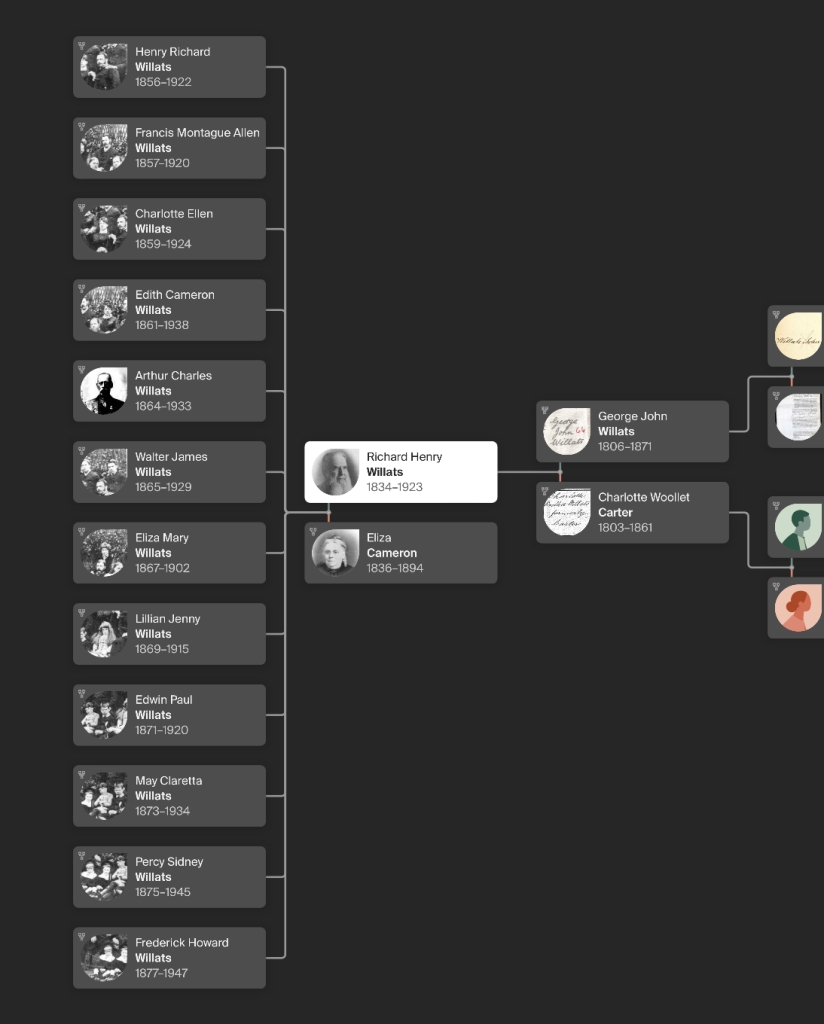
Until next time,
Too-da-loo for now.
🦋🦋🦋
I have brought and paid for all certificates,
Please do not download or use them without my permission.
All you have to do is ask.
Thank you.


Very interesting and well written
LikeLike
Pingback: The Life Of William George Willats (Biggun), 1853-1897, The Early Years, Through Documentation. | Intwined
Pingback: The Life Of Walter James Willats, 1865-1929, The Early Years. | Intwined